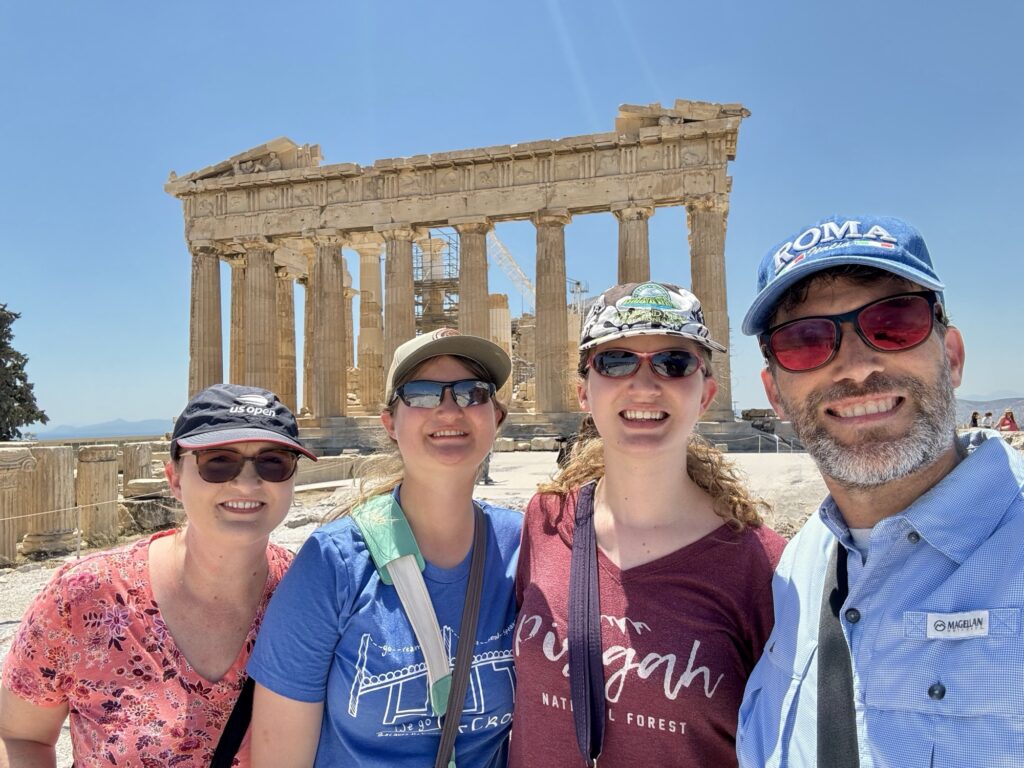
Our final morning aboard the Voyager of the Seas began with a wakeup around 6:30 AM at the port in Piraeus, Greece. We got ready and then went to the Windjammer Marketplace for a final buffet breakfast before getting off the ship.
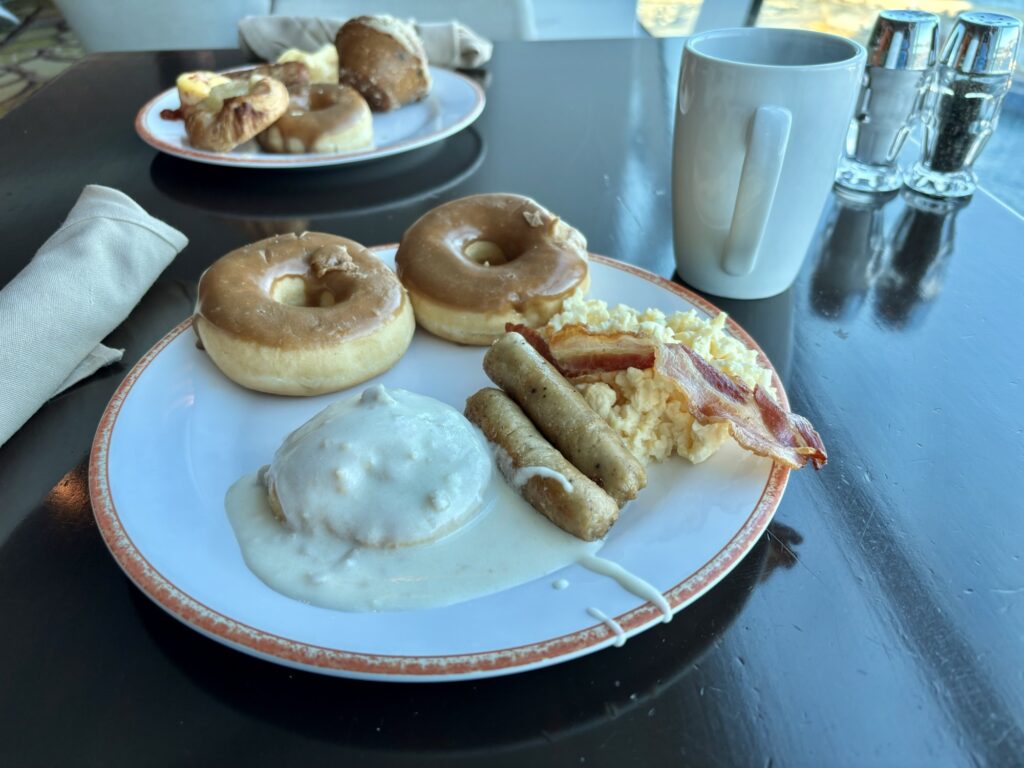
My favorite caramel donuts were back, so I had a couple of those to finish off the cruise.
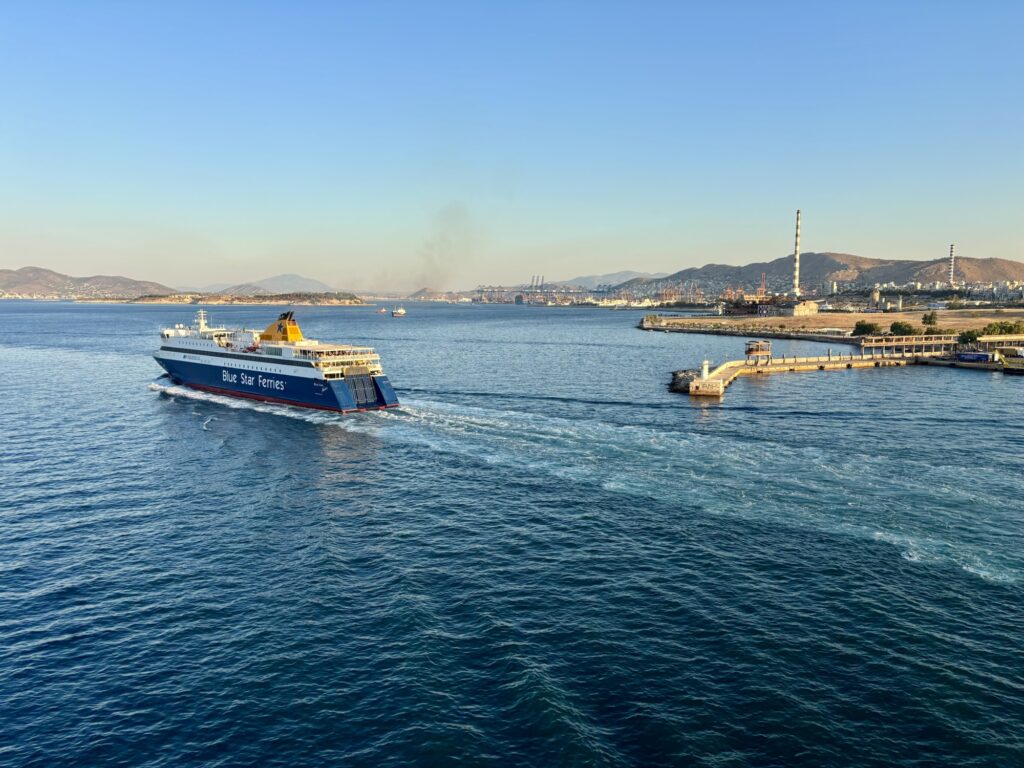
After breakfast, we headed back to our stateroom to pack up our final items and then say goodbye to room 9522. On our way out we were also able to say goodbye to our Stateroom Attendant Amron before heading to the elevators. All week we had skipped the elevators because they take forever on a cruise ship, but with seven bags, this was not really an option today. It took about 15 minutes for all of us to get down to deck one and then we disembarked Voyager of the Seas for the final time.
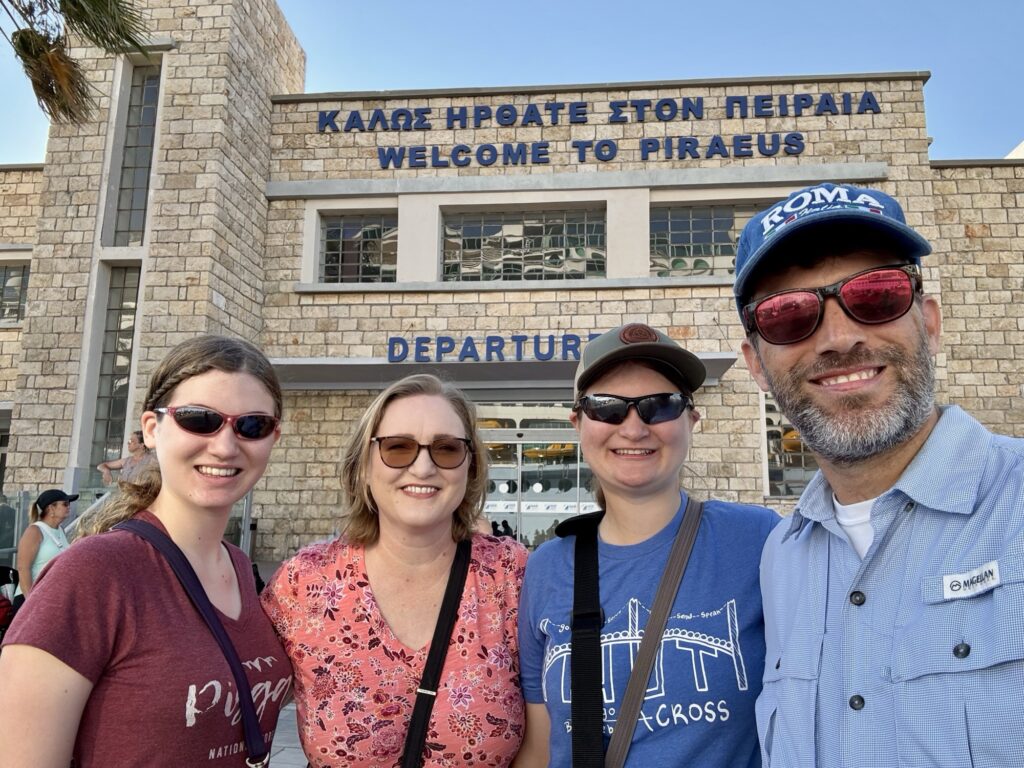
Instead waiting in the long taxi queue, we walked about 3/4 of a mile to the gate of the port and called for an Uber Taxi. A Skoda Odyssey car came and picked us up (was not familiar with this car). It was a tight squeeze as only our three largest bags would fit in the trunk we had to have the remaining bags on our lap. In Athens, all Ubers must be registered taxis, so that is why it is called “Uber Taxi”. Unfortunately there is no Uber XL option for having lots of bags.
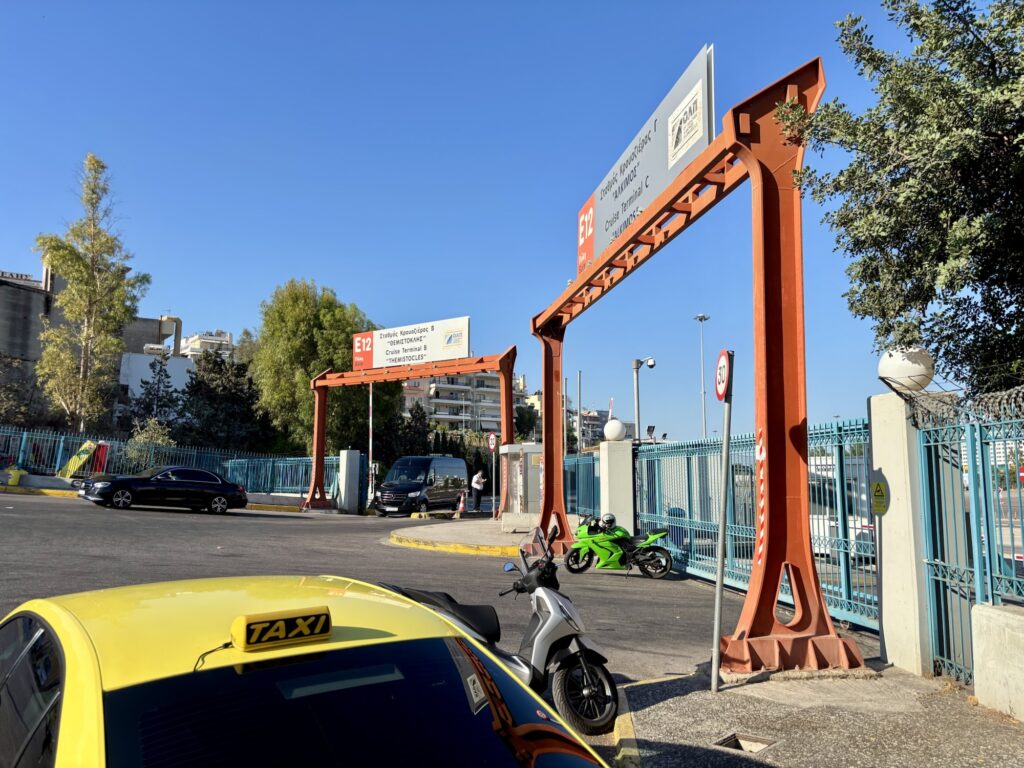
It was kind of surreal, because our driver was listening to American classic rock the whole way. There was some Dire Straits and even some Meat Loaf!
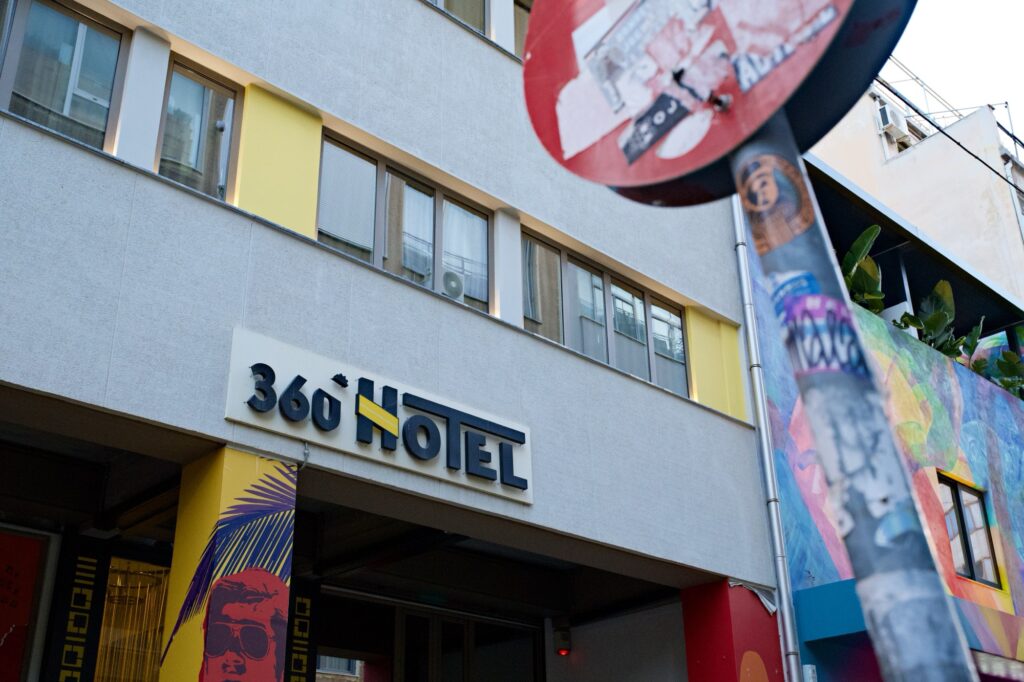
It took about 30 minutes to make it to our hotel, which was A for Athens. We fully expected to just check our bags as it was only about 9:00 AM. The man at the desk told us that due to renovations they were moving us across the street to their sister hotel, which was 360 Hotel. That hotel did not have any rooms for four people, so they upgraded us to two adjoining rooms. Best of all, both rooms were ready!!
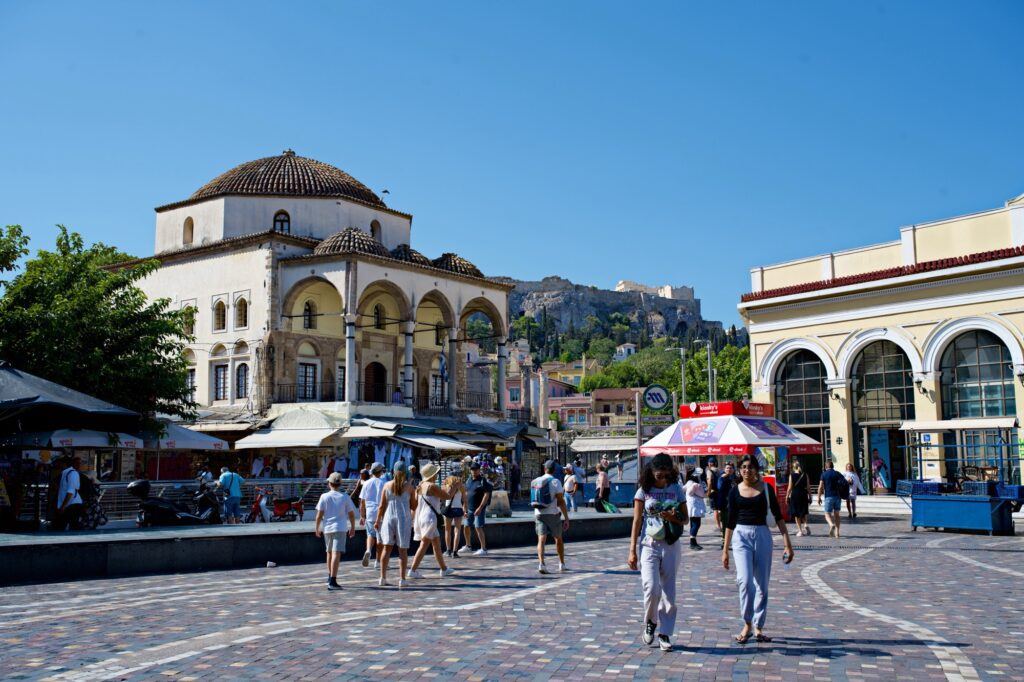
We were able to take all our bags to the rooms, sunscreen up, grab water, and get ready to hit the ground in Athens. We definitely needed the water and sunscreen as it was oppressively hot (upper 90s) and much of our day was spent around marble and stone with no shade. However, today we again walked in the footsteps of the Apostle Paul.
Athens in the New Testament (Acts 17:15-34)
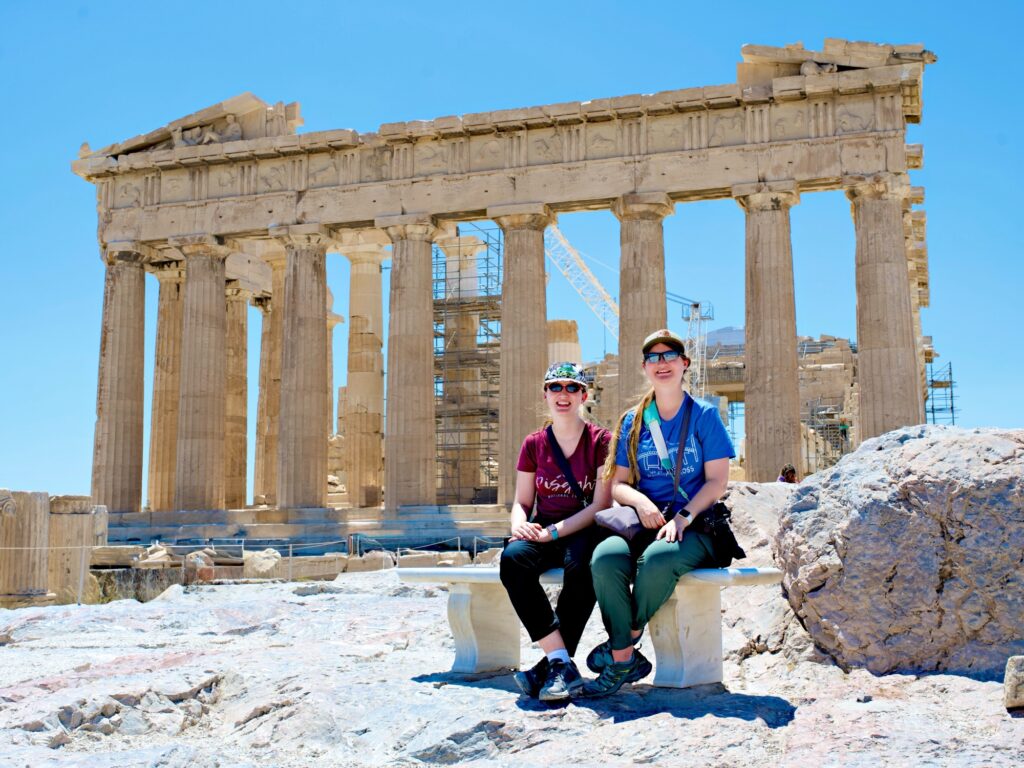
During his second missionary journey, Paul visited Athens after being taken away from Berea by the brothers upon the arrival of Jews from Thessalonica who were stirring up the crowd. Silas and Timothy stayed behind in Berea. While Paul was waiting for Silas and Timothy in Athens, he was “provoked…as he saw that the city was full of idols” (16) and he began to preach in the synagogue and in the marketplace to the Jews as well as the Epicurean and Stoic philosophers, and anyone who happened to be there (17-18). Paul was taken by the people to the Areopagus (Mars Hill) and said “May we know what this new teaching is that you are presenting?” (19).
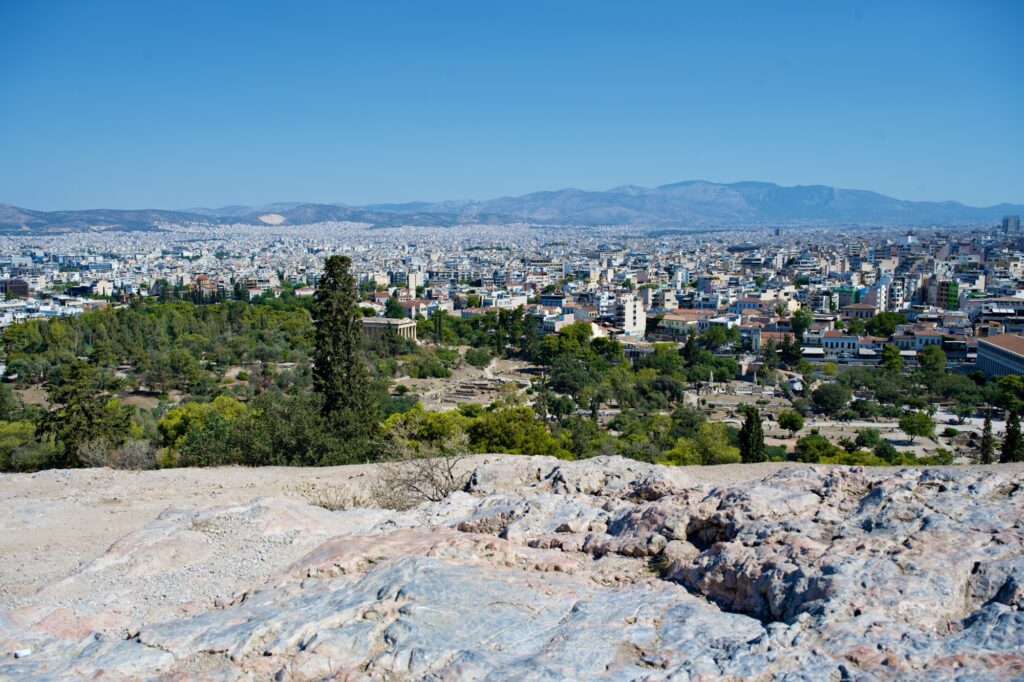
Upon this question, Paul preached his famous sermon on Mars Hill (22-31) before the council. He began by talking about an altar he had seen “To the Unknown God” (23), and uses this to teach about the “God who made the world and everything in it…” (24). The members of the council listened as Paul preached, but some mocked once he mentioned that God would “judge the world in righteousness by a man whom he has appointed; and of this he has given assurance to all by raising him from the dead.” In response to his preaching, Dionysius the Areopagite (a member of the council) and a woman named Damaris (among others) “joined him and believed” (34). After this, Paul departed for Corinth.
Areopagus
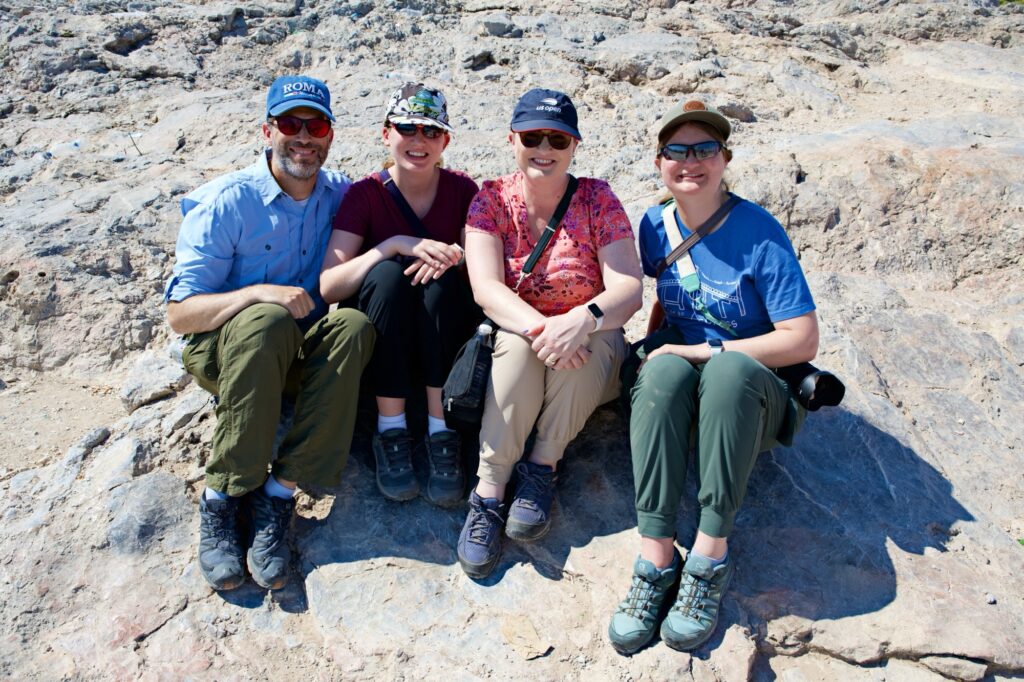
Our first stop in Athens was to the Areopagus which is just to the northwest of the Acropolis. This was only about a half a mile from our hotel, across Monastriaki Square, past the Roman Agora ,and up a very steep hill to the base of the Acropolis. From there we made a short walk around to the Areopagus.
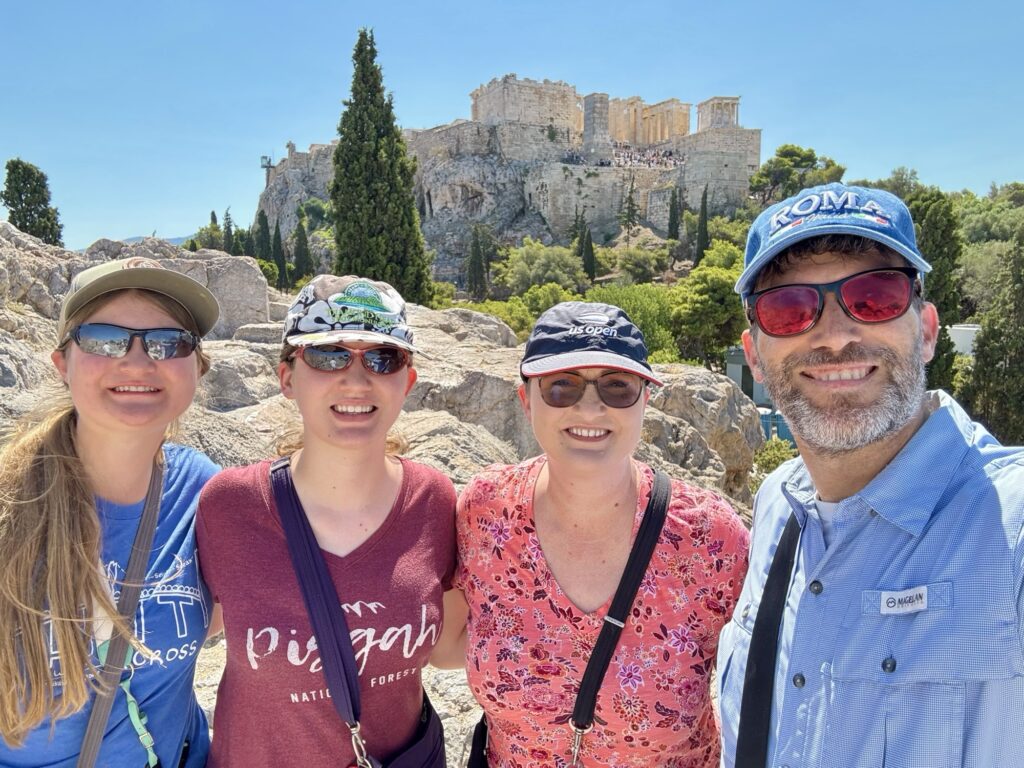
The Areopagus is a rocky outcrop (hill) approximately 115 meters tall. The name is probably derived from Ares, the god of war.
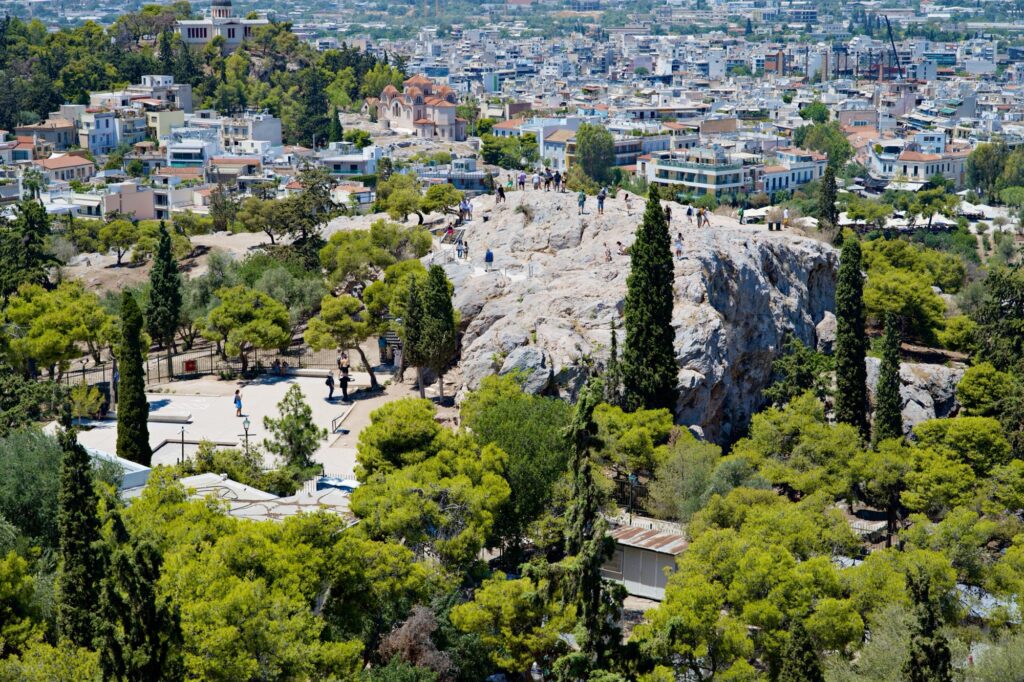
This is the reason for the name “Mars Hill,” as Mars was the Roman equivalent of the Greek god Ares. A judicial body, the Areopagus Council, met on this hill to preside over cases of murder, sacrilege, and arson.
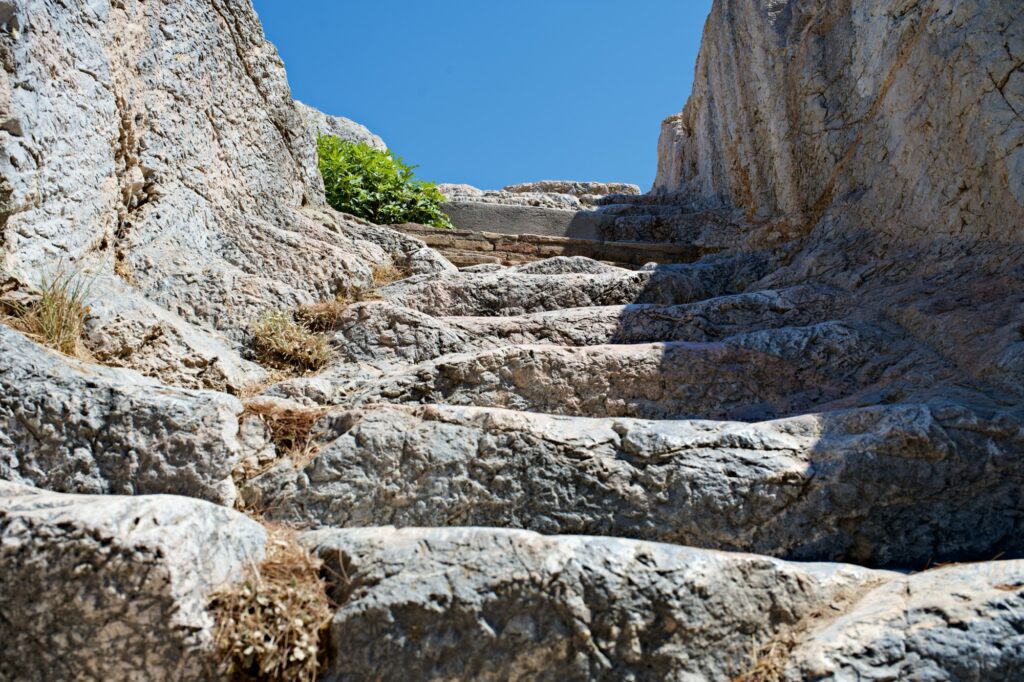
Upon arrival at the Aeropagus, we climbed up using the modern staircase that has been installed, but I also took some photos of the ancient staircase to the top. Many years ago when I was working at Gospel Advocate Company, we did an issue of the magazine that featured articles based on Paul’s sermon on Mars Hill. I called my mentor, Dr. Marlin Connelly (he had been to Athens many times), and asked if he had any good pictures of the Aeropagus that we could use in the magazine. When he came to the office, the first picture that he showed me was very similar to the one that I have above, and it was very important for me to get this shot.
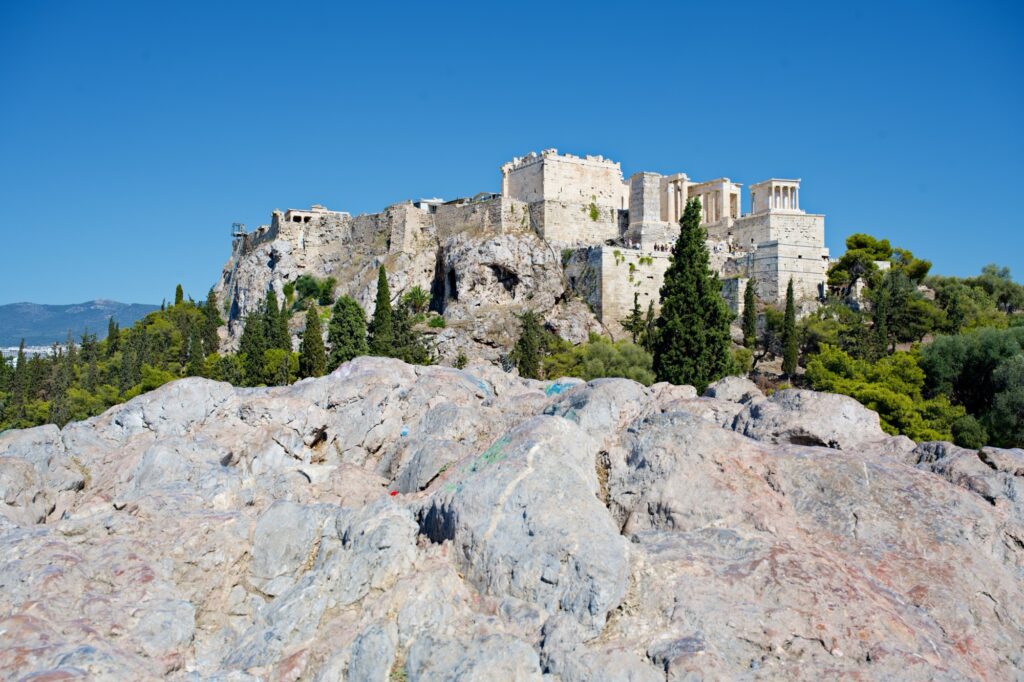
Up on top of Mars Hill, it was pretty crowded, and the rocks are very slick, but the view of the Acropolis above, and the city below, were incredible.
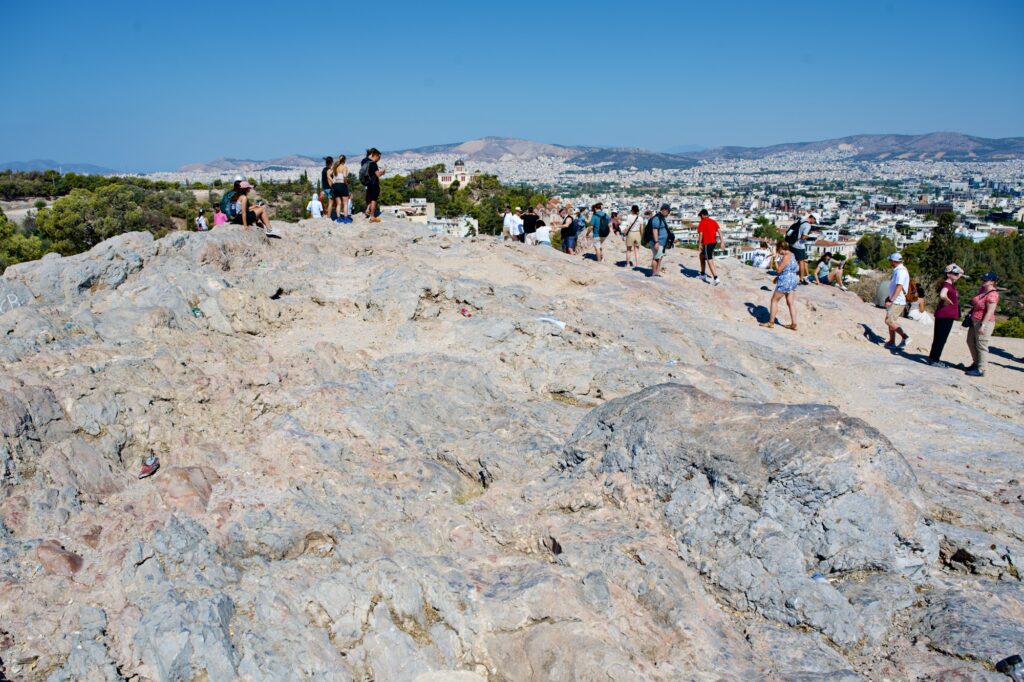
We slowly navigated through the people and slick rocks to find a place where we could have a little room to ourselves.
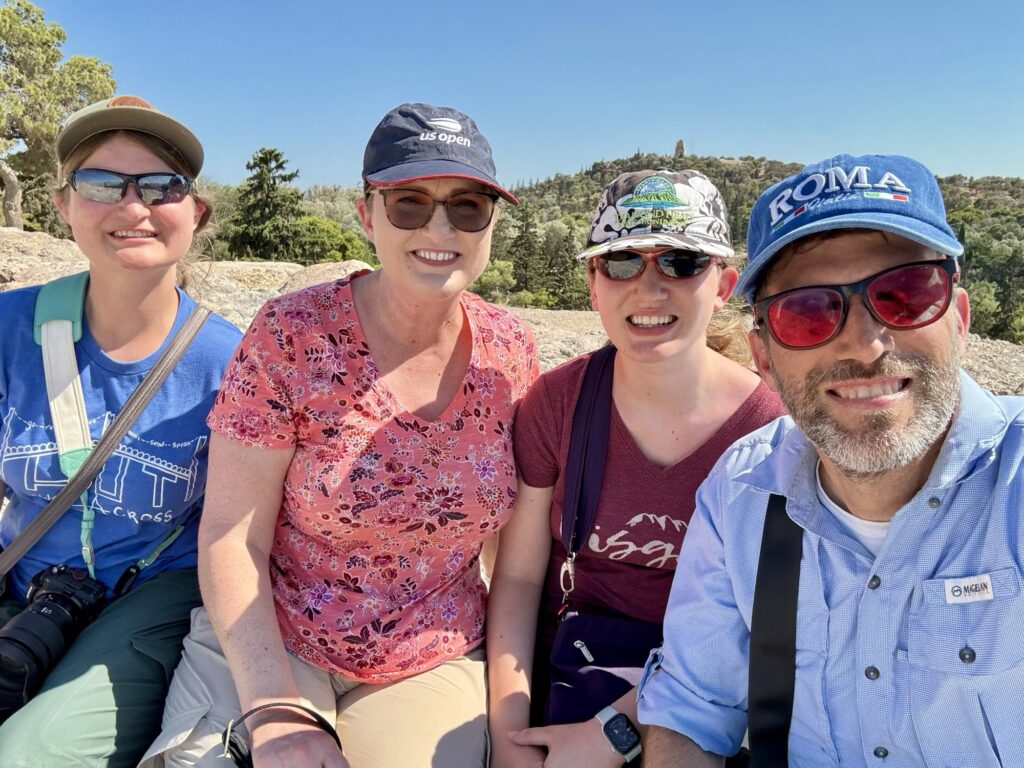
Once there, I read the entire account of Paul in Athens from Acts 17:15-34, including his sermon on Mars Hill. After spending a few more minutes contemplating the significance of Paul preaching from this place, we found someone who took a picture of us against the rocky surface. It was amazing to know this was a place where the Apostle Paul walked and preached.
The Roman Agora (i.e. the Marketplace)
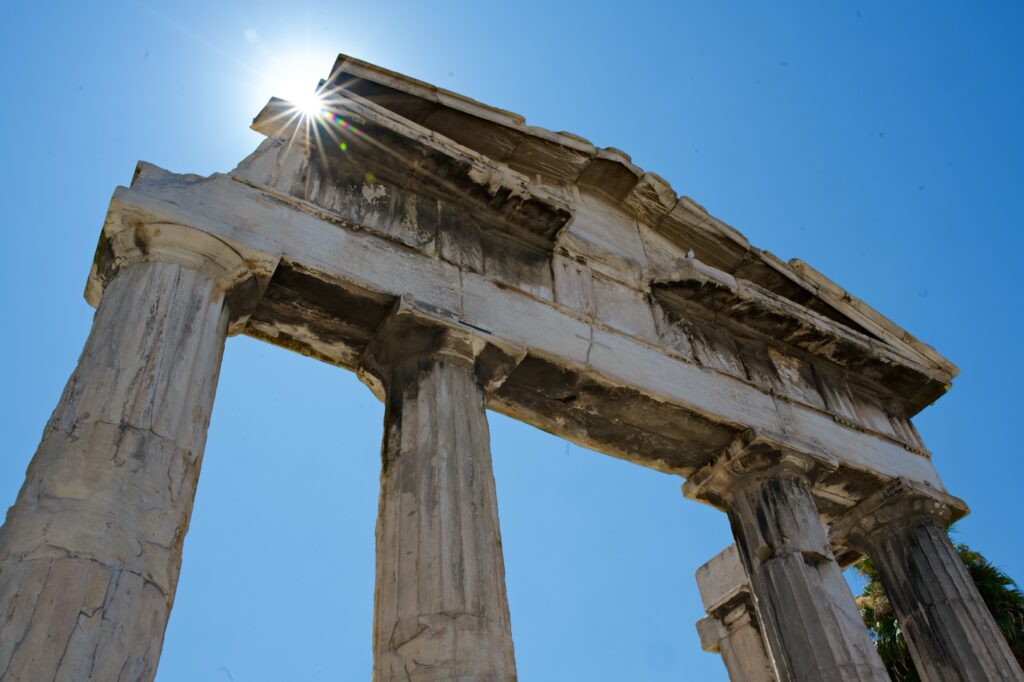
After leaving the Aeropagus, we came back down the hill to the remains of the Roman Agora of Athens. The Roman Agora (public square or marketplace) was built in the late first century BC with the goal of replacing the Ancient Agora as the commercial center of the city. The Ancient Agora had become overcrowded due to several large building being built in the center. The Roman Agora is about 100 meters to the east of the Ancient Agora.
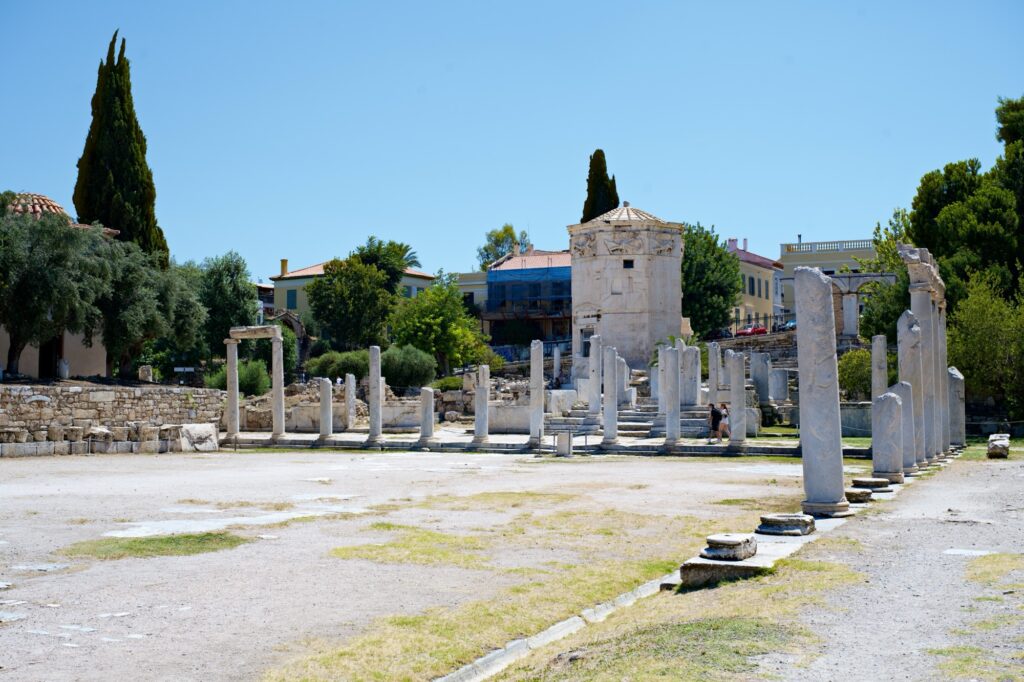
It was a rectangular building or portico that was 111 x 104 meters with an open courtyard in the middle. The porticos were supported by two rows of columns and would have been filled with shops and offices. This is most likely the marketplace mentioned in Acts 17:17 where Paul preached upon arrival in Athens (see above).
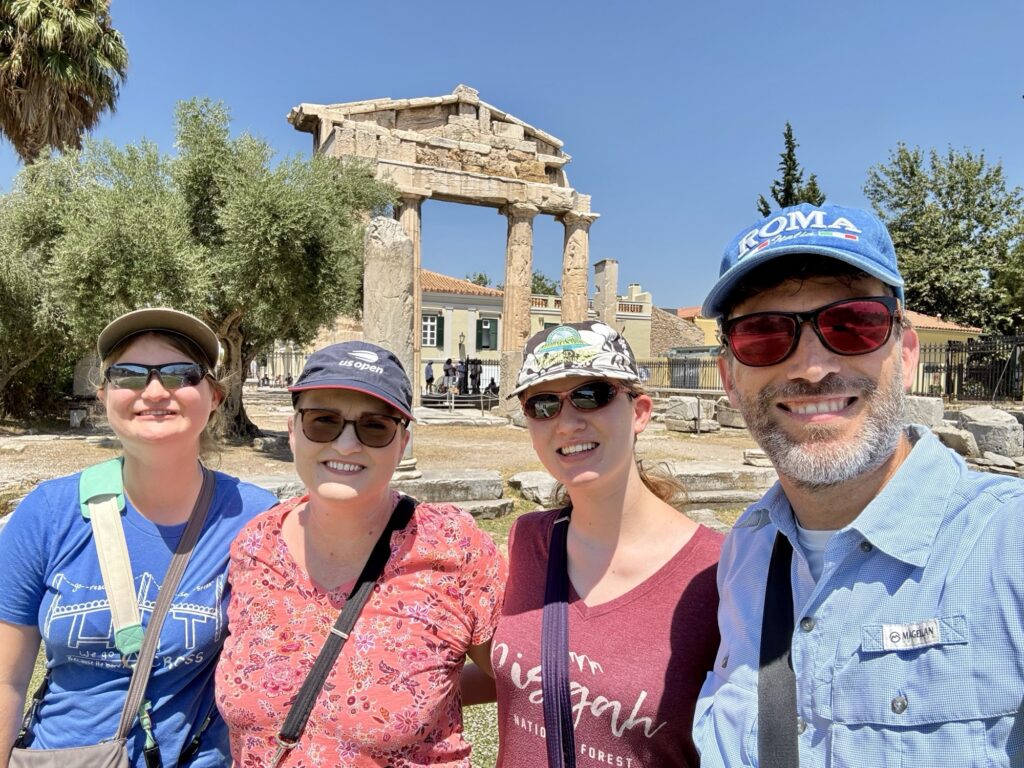
The first thing we saw upon entry was the remains of the magnificent Gate of Athena (West Propylon) on the west side of the Roman Agora. This was one of two main gates (propylaia) of the Roman Agora.
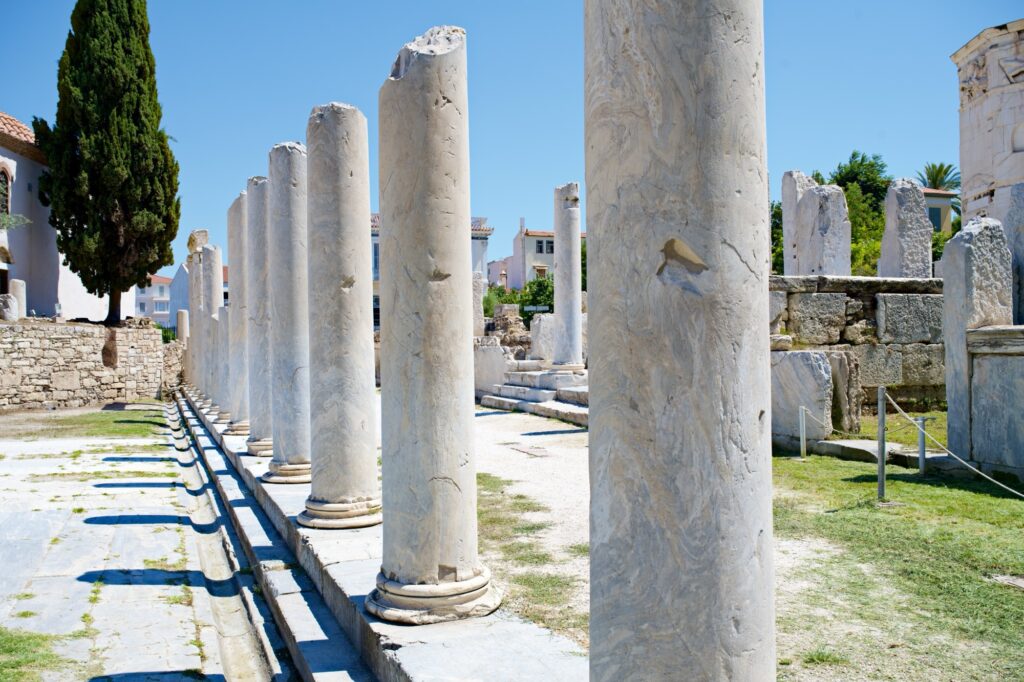
Next we could see the remains of the two rows of columns on the south and east part of the site along with the area where the shops and offices would have been.
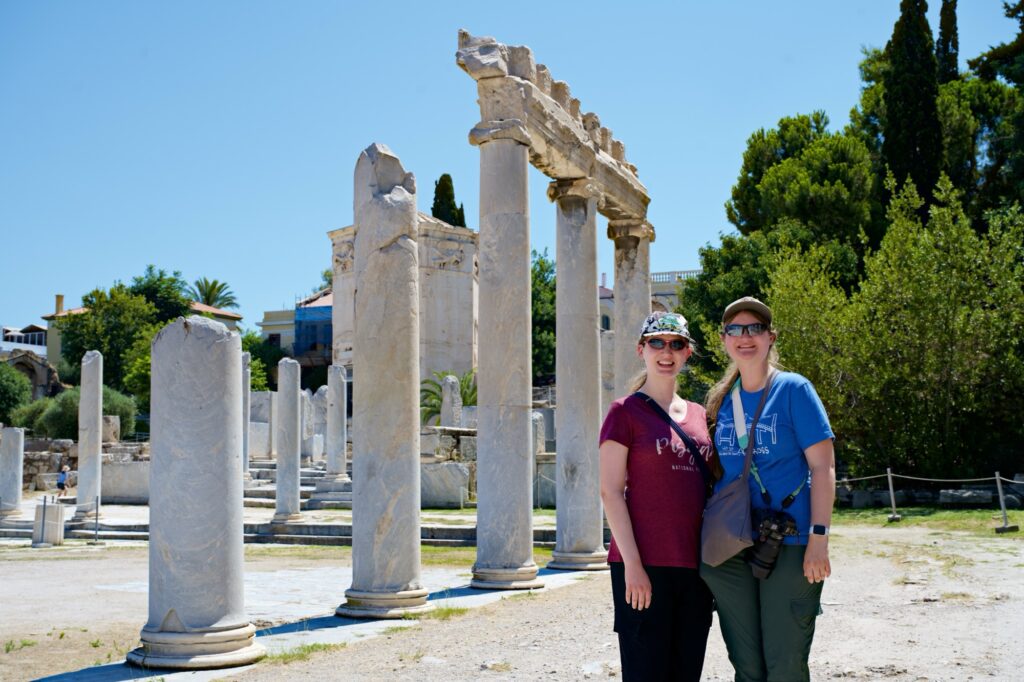
It is pretty crazy to think that Paul would have walking through these porticos preaching and teaching the gospel.
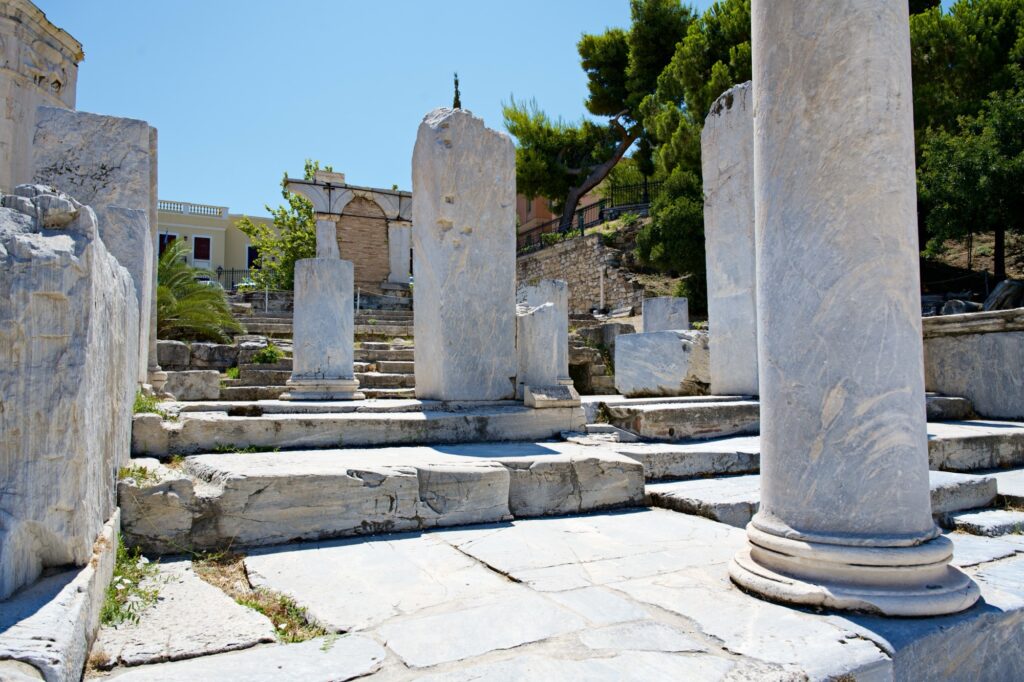
On the east end of the site we saw the remains of East Propylon (gate), the second main gate of the Roman Agora.
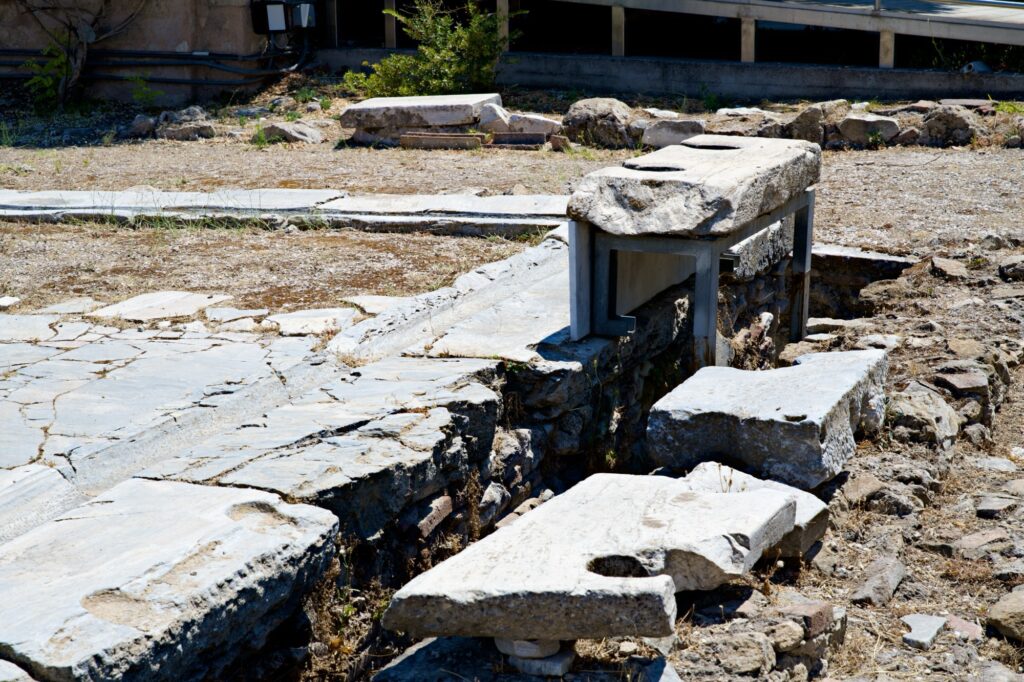
On northeast part of the site, we saw the remains of a public toilet for those in the Roman Agora. It was built in the first century AD.
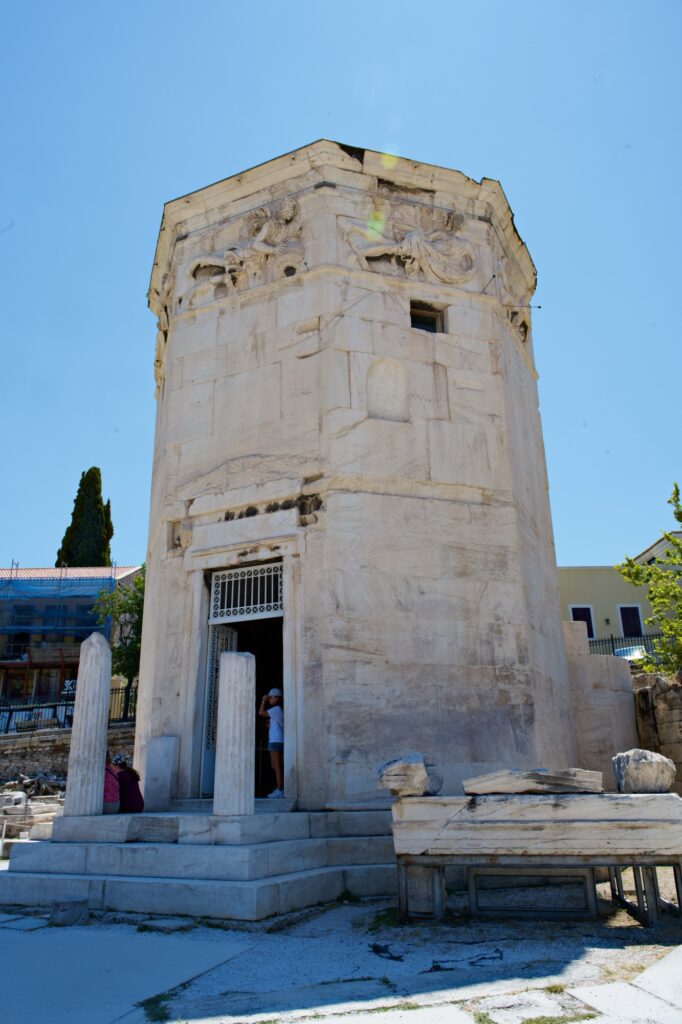
Just outside of the Roman Agora, on the east side, we saw the Horologion οf Andronicus Kyrrhestus (Tower οf the Winds). This was an octagonal marble tower with a bronze weather-vane (no longer preserved) on the roof indicating the direction of the winds.
Acropolis
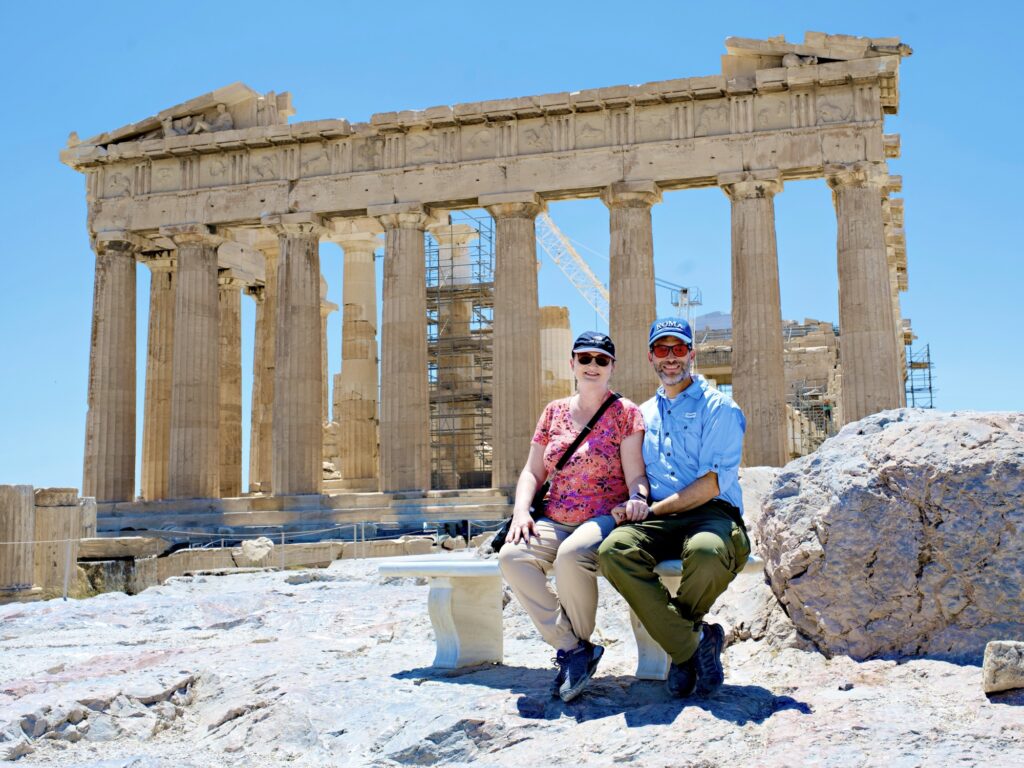
Once we finished exploring the Roman Agora, we grabbed some new water bottles from a nearby vending machine and rested for a bit before heading back up the hill to the Acropolis. We had 1:00 PM tickets to the Acropolis and made it to the entrance queue about 20 minutes early. Once the gate opened, we made our way into the site and further up the hill toward the magnificent structures on the site.
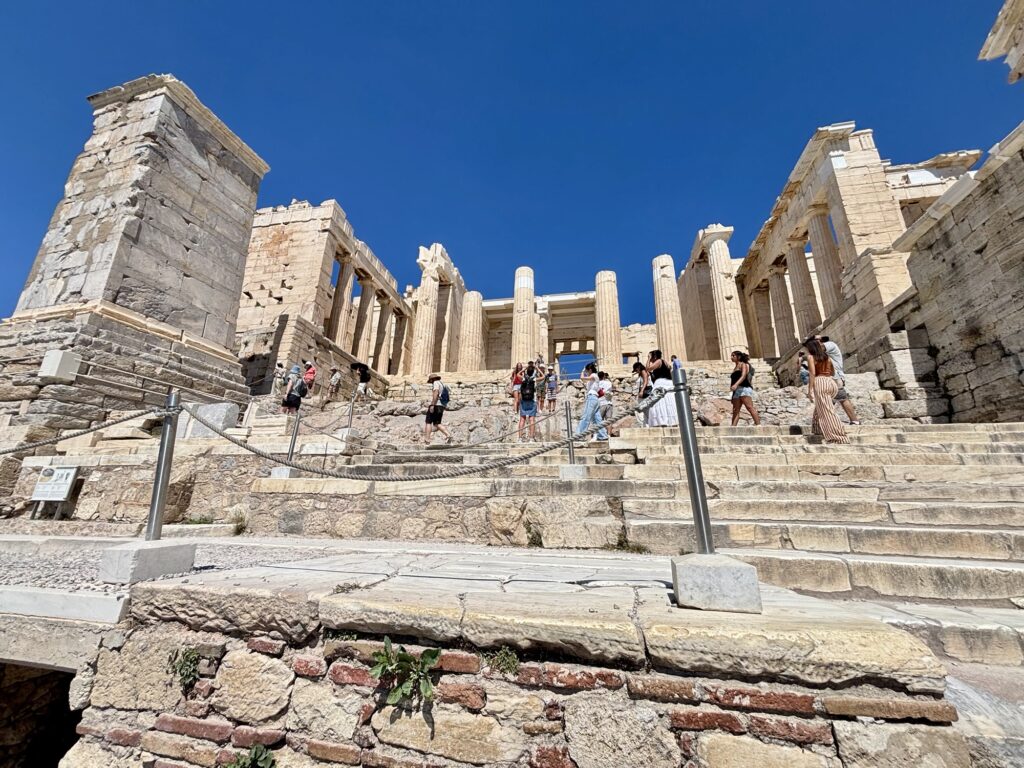
The Acropolis of Athens has been inhabited since the Neolithic era. During the Mycenaean (13th century BC), it was fortified and became the seat of the local ruler. Buildings fdedicated to the goddess Athena were first built in the 6th century BC. The buildings on the Acropolis that still remain today were mostly built in the 5th century BC over a 50 year period during the Golden Age of Greece (classical period). The primary buildings, such as the Propylaia, the Parthenon, the Erechtheion and the Temple of Athena Nike, were all initiated by political leader Pericles.
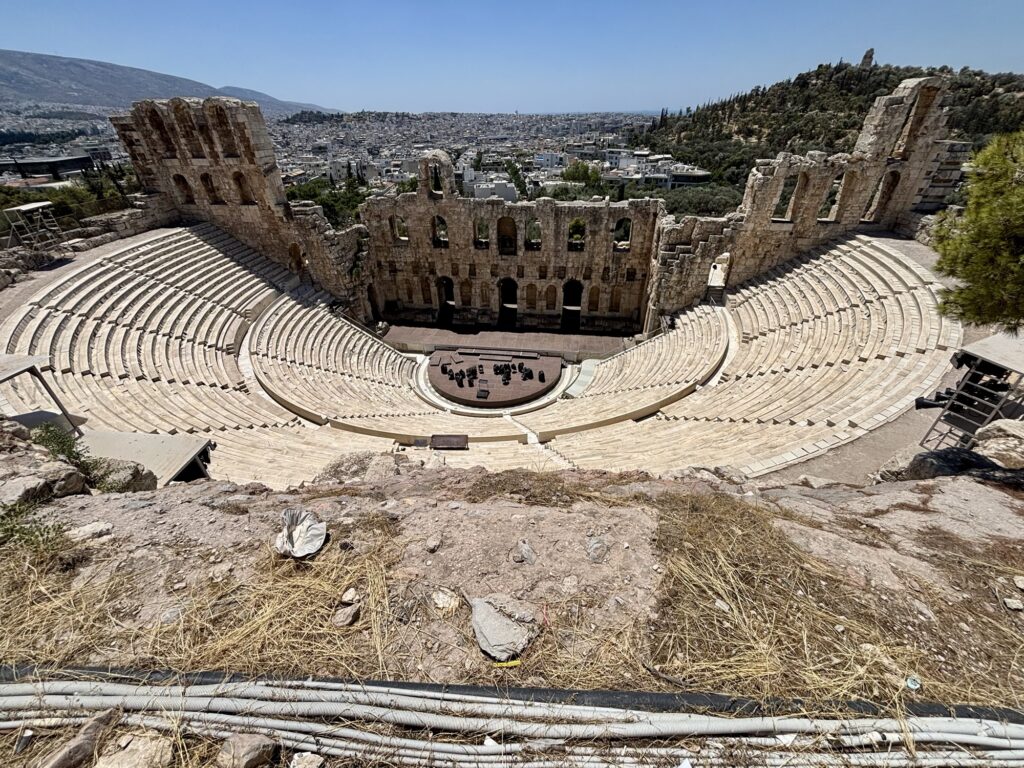
Before going up on top to see these four magnificent structures, we first went off to the right from the main entrance to see the Odeon of Heredes Addicus. This was a 5,000 seat theater built during the second century AD that has been fully restored to host modern day events and concerts. It was built by Heredes Addicus, which is where its name comes from. The theater originally had a roof.
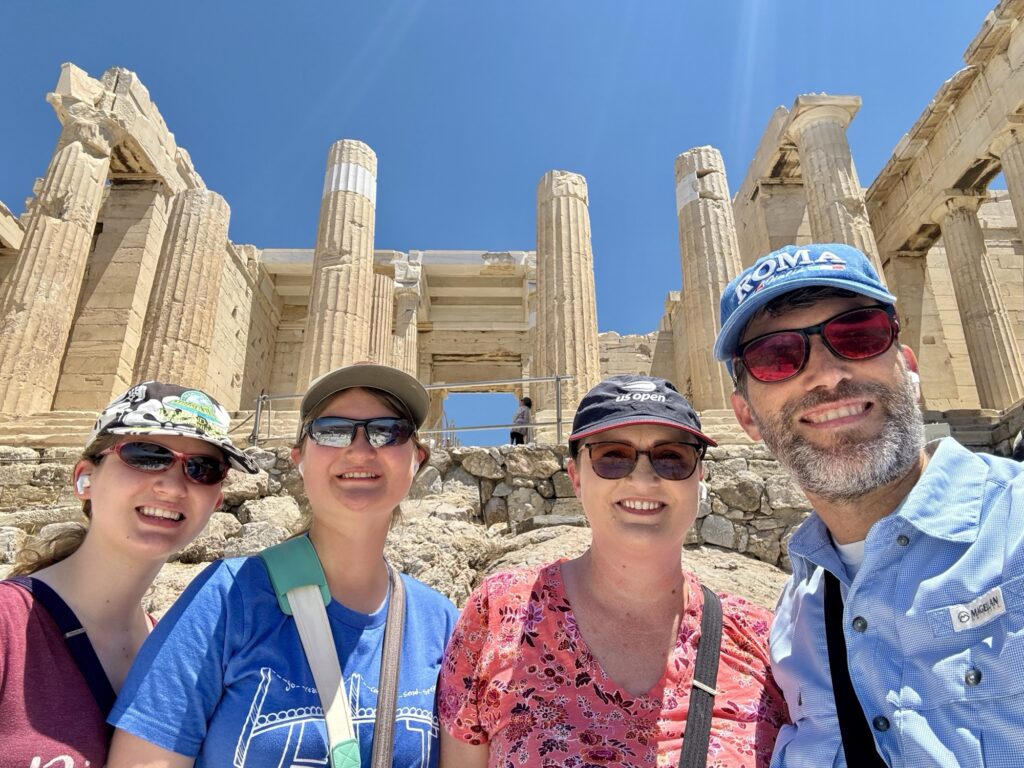
Next we went up to the awesome Propylaia, which was the main entrance of the Acropolis with marble stairs and six columns on the western and eastern facades. Originally there would have been passageways between each of the columns for entry into the site. This gate was massive, but was apparently only a portion of what was originally planned.
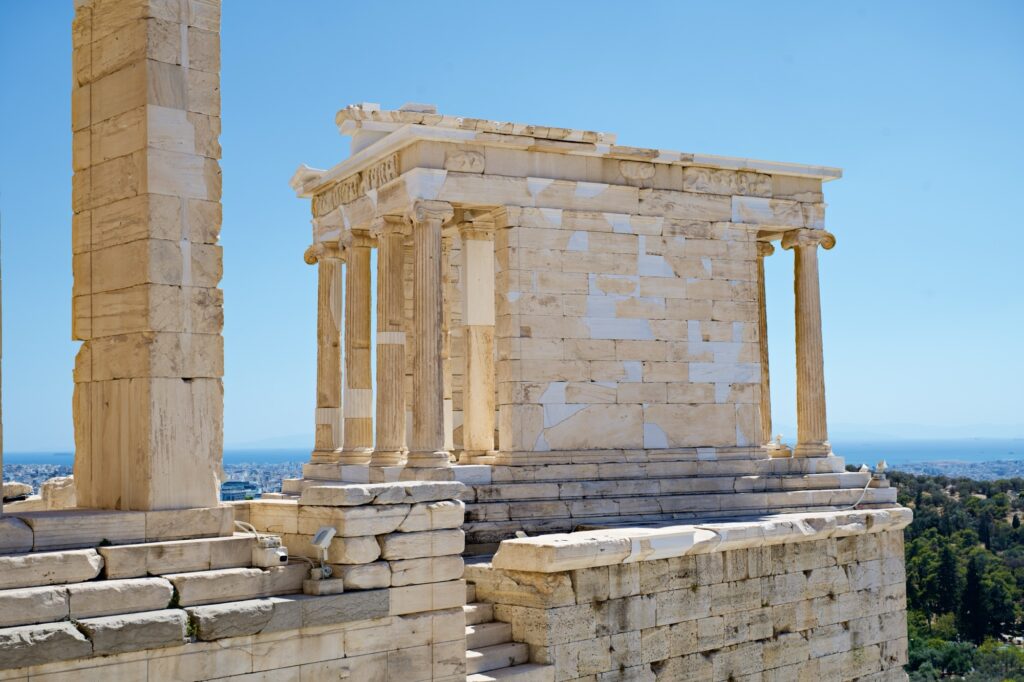
From our perspective on the western side of the site, we could see the Temple of Athena Nike, which is a small, columned structure up on top of the Propylaia and to the right. The name for this temple comes from reliefs of both Nike and Athena on the structure. The temple has four columns on the front and back.
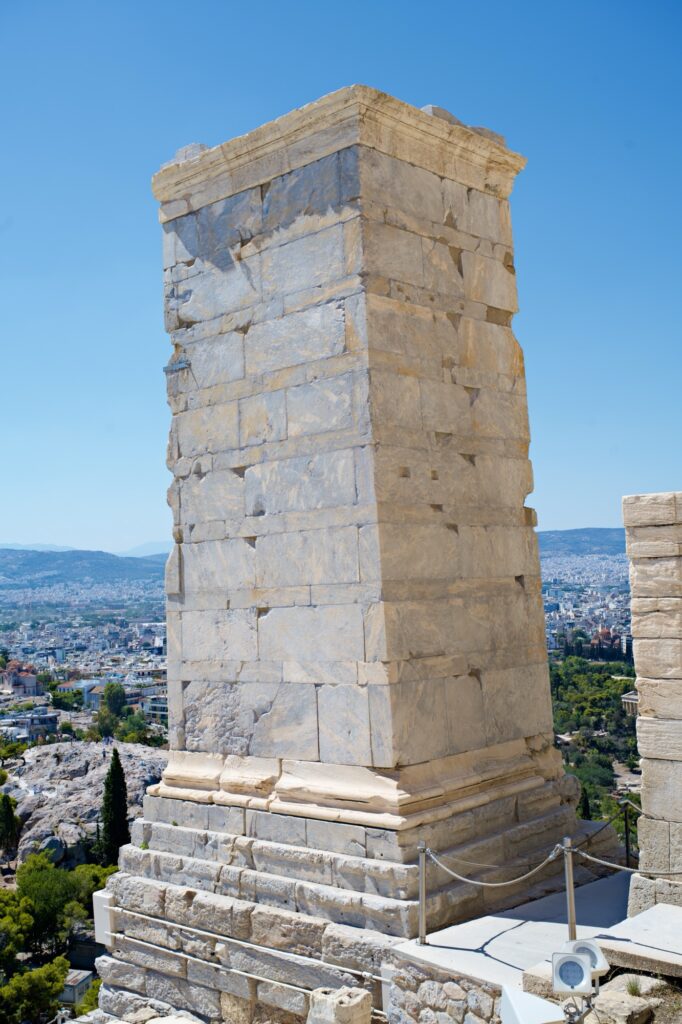
On the left side of the Propylaia we saw the Tower of Agrippa, which is a tall pedestal with nothing on top. This tower dates back to the second century BC, and has had many different items up on top over the centuries. It was eventually dedicated by the Athenians to Marcus Vipsanius Agrippa, son-in-law and general of the Roman Emperor Octavian Augustus.
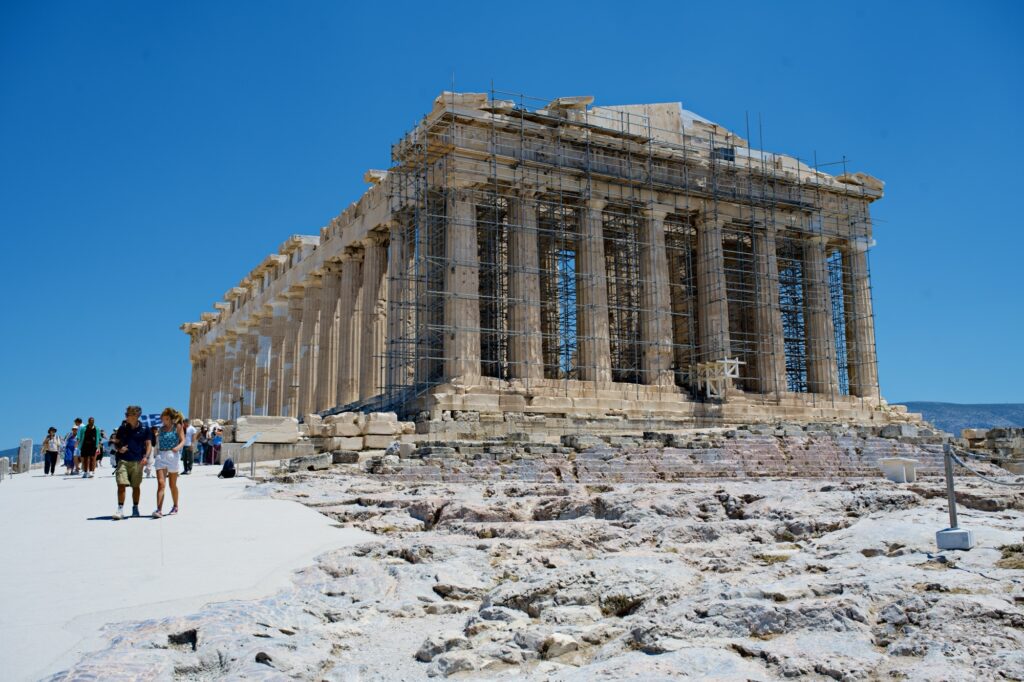
Walking through the Propylaia from west to east, we caught our first close-up views of the Parthenon. It is in the middle of a two year project to reinforce and refurbish the structure, so the west side of the facade is covered in scaffolding. Even so, this first view is still breathtaking.
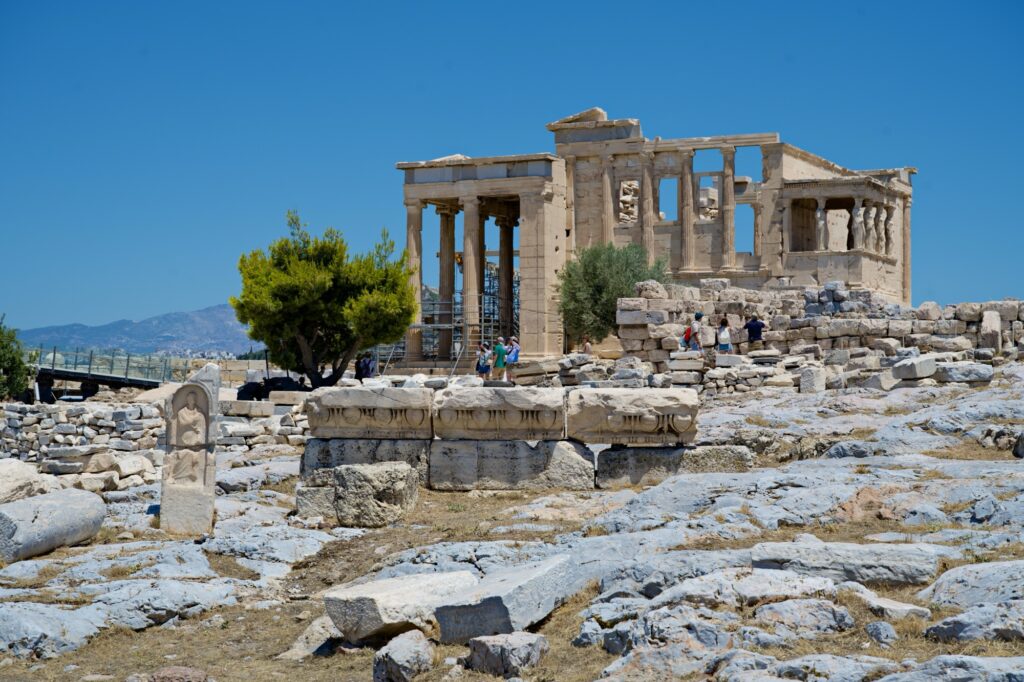
Before walking up to the Parthenon, we saw the base where the colossal bronze statue of Athena, known as Athena Promachos, once stood. The exact form of this statue is unknown, but it was dedicated by the people of Athens to Athena to express gratitude for victories in the Persian wars.

The Parthenon was a temple dedicated to Athena Parthenos (Virgin). It is built in the Doric order and made of white Pentelic marble. This was the most important building for the re-establishment of the Acropolis after the destruction by the Personas in 480 BC. Inside the temple was a gold and ivory statue of the goddess. The statue is not preserved, but its appearance is known from ancient writers and later copies. On a side note, I heard several guides throughout our time on the site mention the replica of the Parthenon in Nashville and the statue of Athena on the inside.
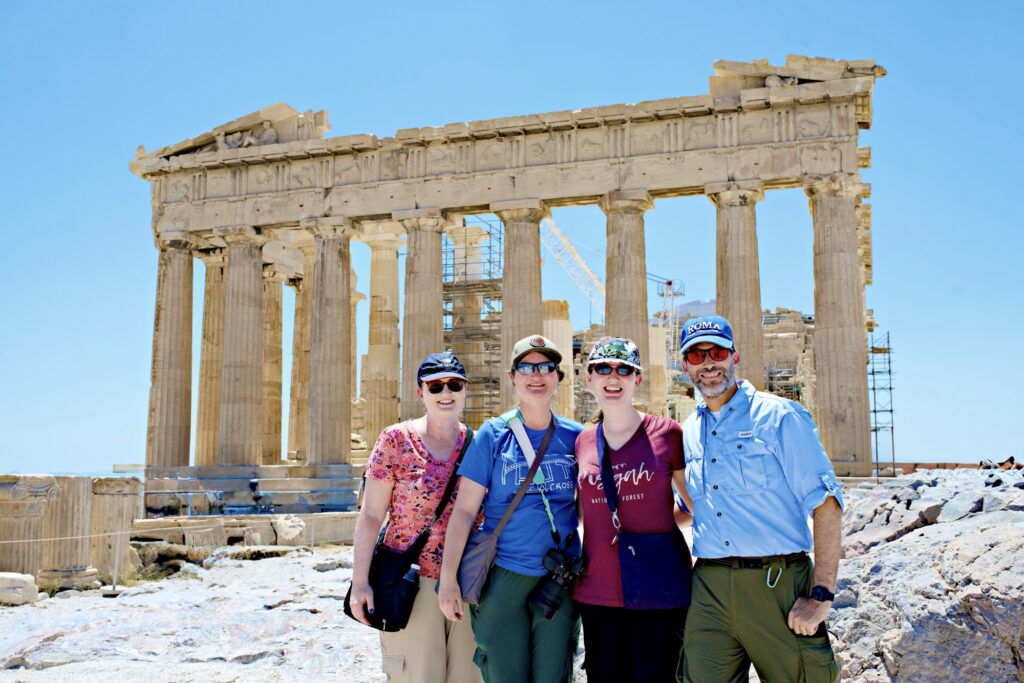
Throughout our time on the Acropolis we walked around the entire remaining structure of the Parthenon. Fortunately, the eastern end is not covered in scaffolding, so we were able to get some good pictures from that side. I asked a nice young lady if she would take our family picture with my iPhone. When she saw the mirrorless camera around my neck, she offered to take it with that instead. I almost never ask anyone to use my “professional” cameras, because they usually look at me like I’m crazy. Not only did she offer to use it, but once I showed her how I wanted the shot, she nailed it. This is probably my favorite picture from the trip.
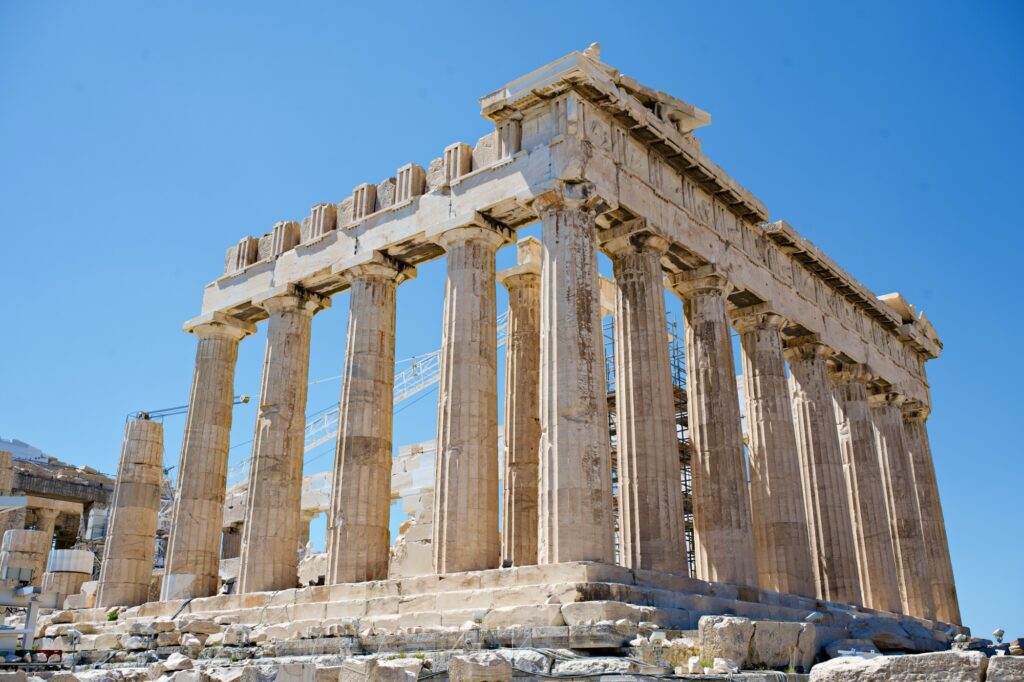
As we walked around the Parthenon, we could see the effect of all the damage over the centuries. We were listing to an audio tour of the site, as well as reading the signs, and learned about many of the things that happened. These included…
*In the late 3rd or late 4th century AD, the interior of the temple was destroyed by fire from either a Germanic tribe or by Alaric’s Visigoths.
*In 1687, during the siege of the Acropolis by the troops of Venetian general Francesco Morosini, a cannonball made a direct hit in the interior of the temple, which the Turks used as a powder magazine. The terrible explosion blew up the roof and destroyed the long sides of the temple as well as parts of its sculptures.
*The most severe damage to the monument was caused in 1801-1802, when the Scotch ambassador of England to Constantinople Thomas Bruce, 7th Earl of Elgin, removed the greatest part of the sculptures that also comprised structural members of the temple. By bribing the Turkish garrison of the Acropolis and employing teams of the Italian artist G.B. Lusieri, Elgin removed and transported to England 19 pedimental sculptures, 15 metopes and the reliefs of 56 sawn blocks of the frieze, today exhibited in the British Museum in London. During our time in Athens, I saw several signs asking people to sign a petition to bring these treasures back to Greece.
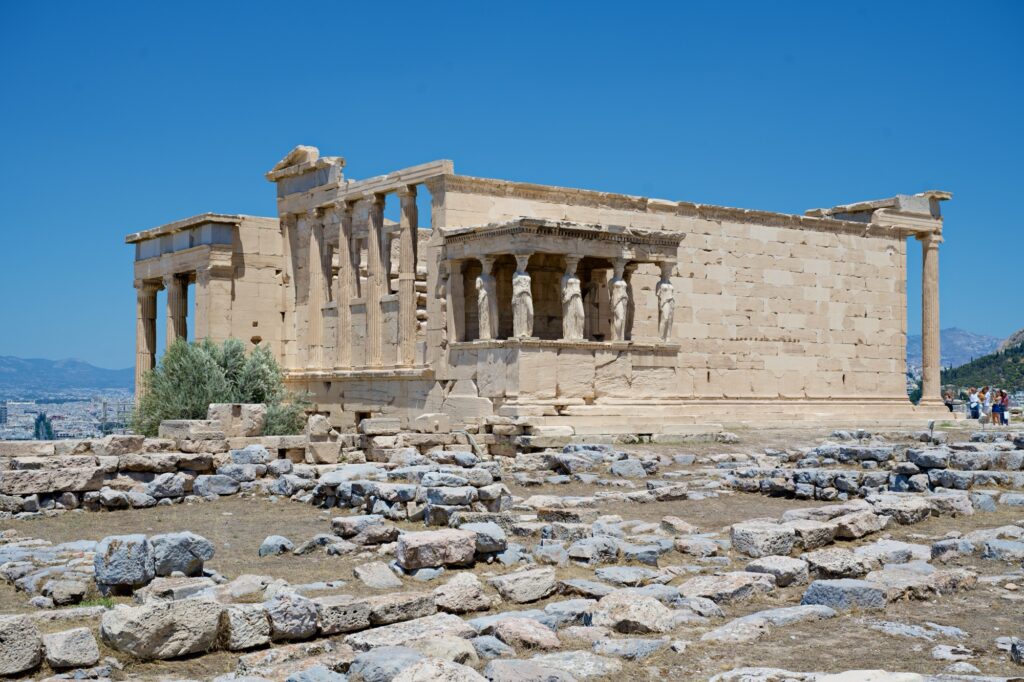
To the north side of the site, we saw the remains of the Erechtheion. It is called the Erechtheion from the name of Erechtheus, the mythical king of Athens.
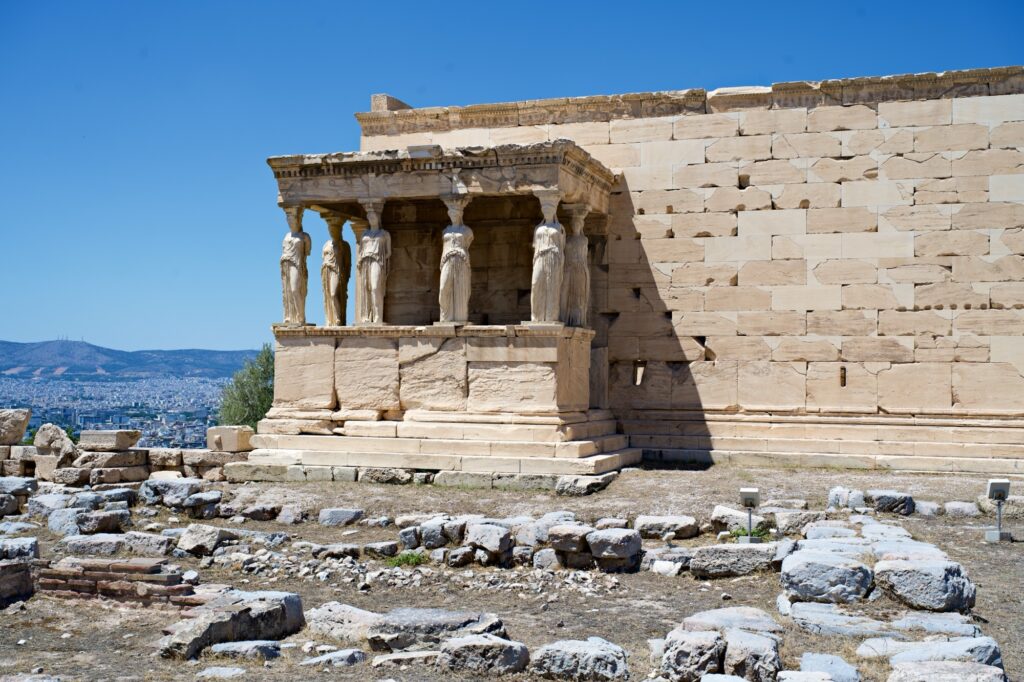
On the south side of this structure is the famous Porch of the Maidens with six columns of young women supporting the roof. These columns today are reproductions as the originals were removed for preservation. This columns of the young women were one of Olivia, Kate, and Sara’s favorite things on the site.
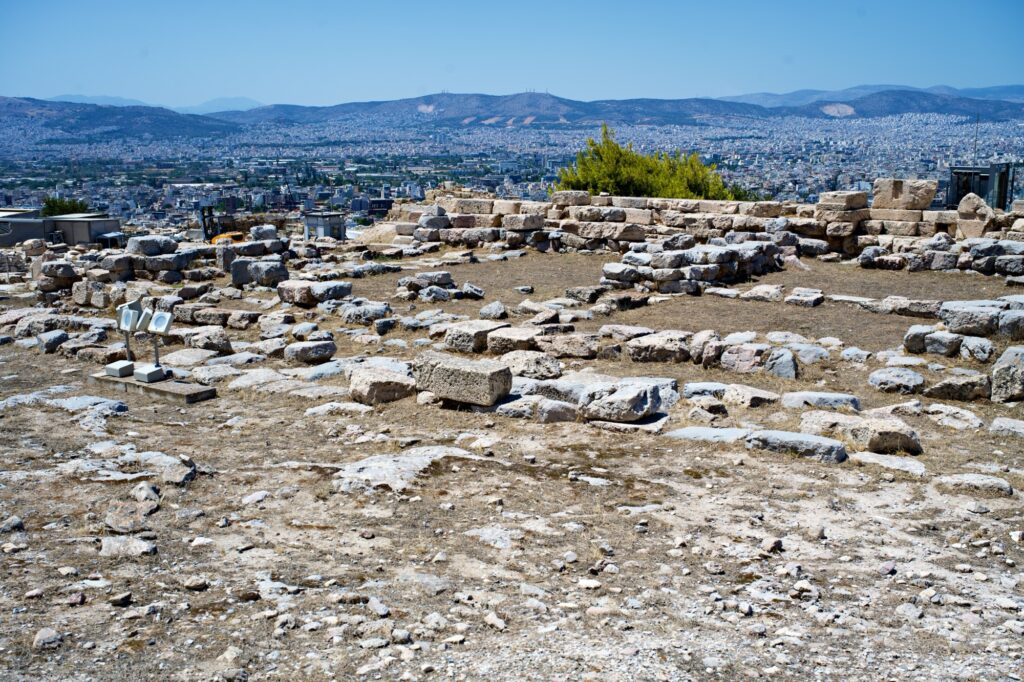
Further to the south of the Erechtheion is the foundations of the old temple of Athena, which was built in the sixth century BC and destroyed by the Persians.
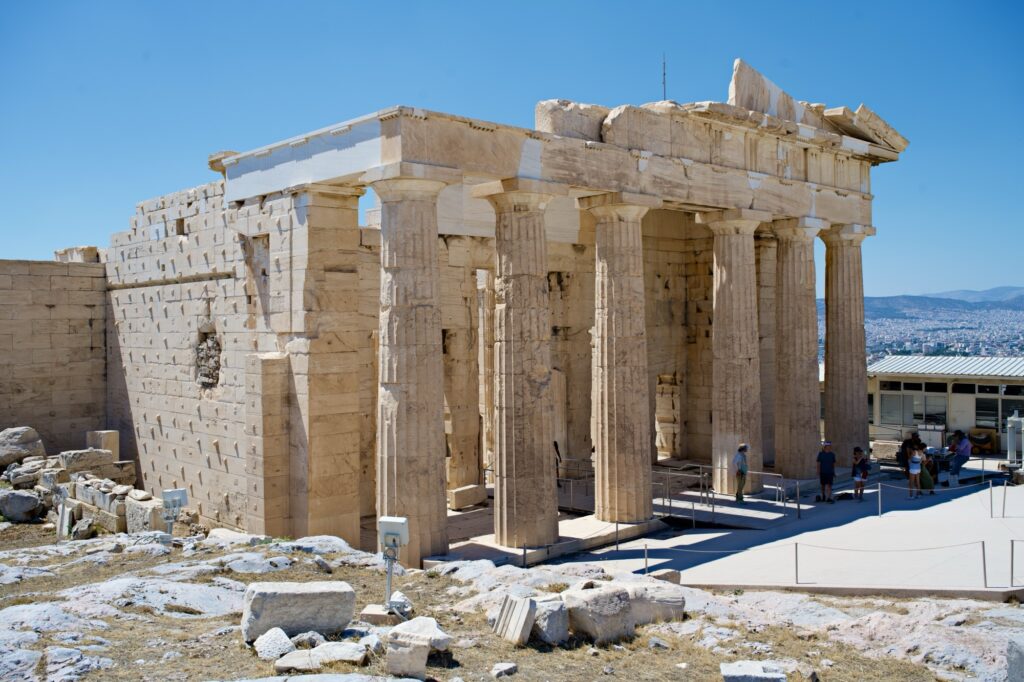
Even though it was crazy hot, and we were all very tired, we still spent quite a lot of time exploring the Acropolis and marveling at the amazing structures that remain. Outside of the Parthenon, my favorite was the Propylaia. I spent a few minutes photographing this amazing building.

While I generally love having a guide, one of the benefits of doing a self paced tour is being able to take some extra time for creative photography. One thing that struck me while walking around were the words Luke recorded about Paul’s visit to Athens in Acts 17:16, “his spirit was provoked within him as he saw that the city was full of idols” I feel confident the Acropolis was one of the places he had in mind.
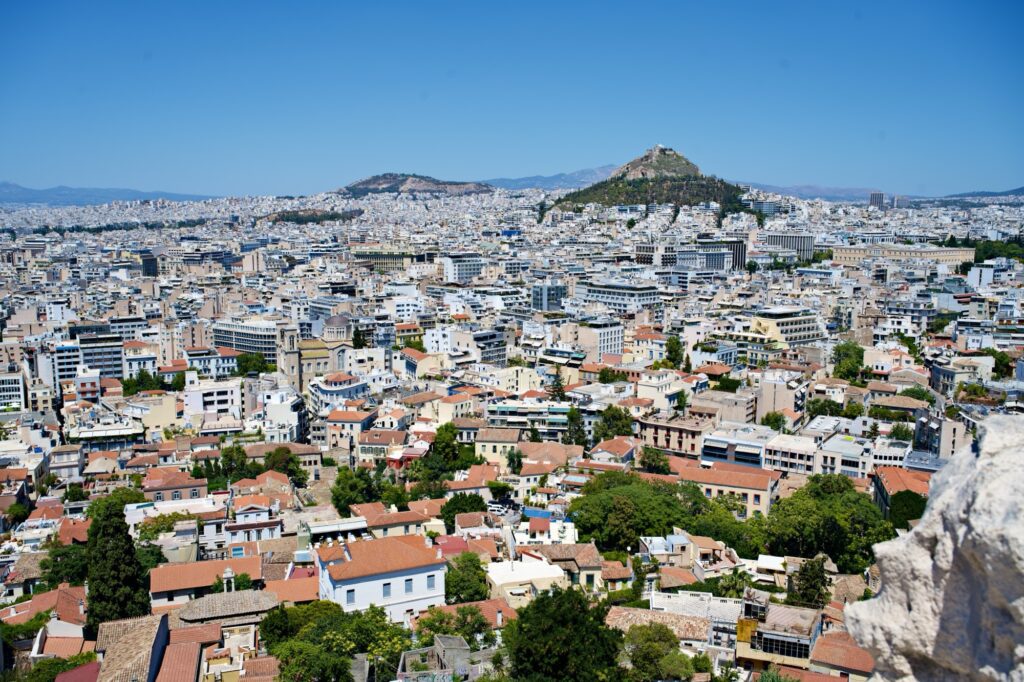
By the way, the views of Athens from the top of the Acropolis are amazing. I grabbed shots from ever angle I could while walking around by the Acropolis walls.
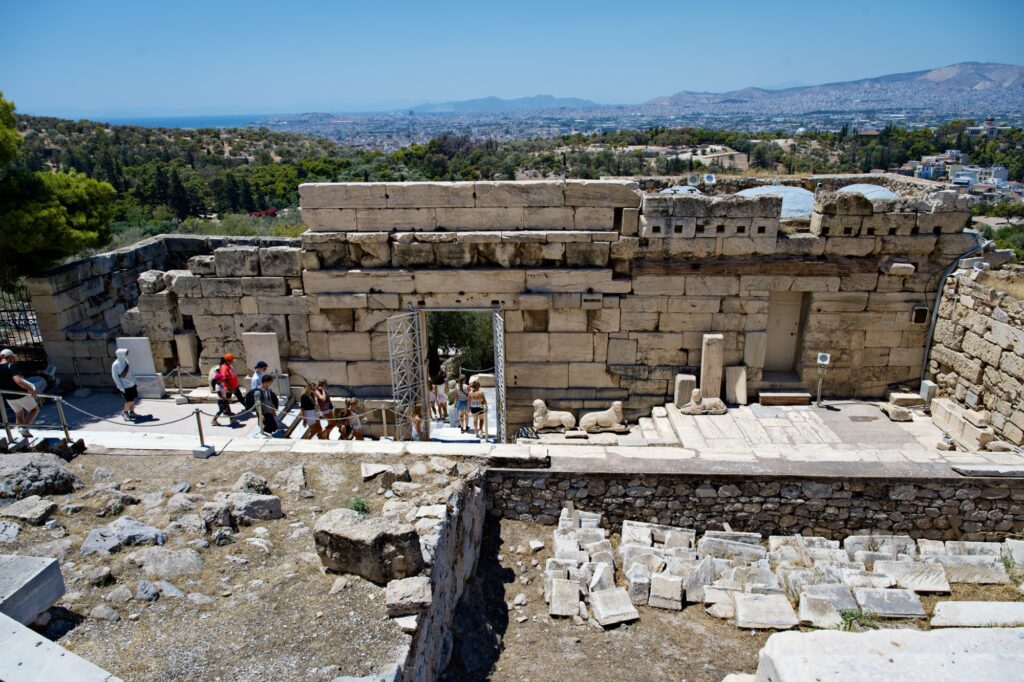
Once we had fully explored the top, and refilled our water battles several times (having a bottle filler on top was so nice), we exited the top of the Acropolis site through the Propylaia.
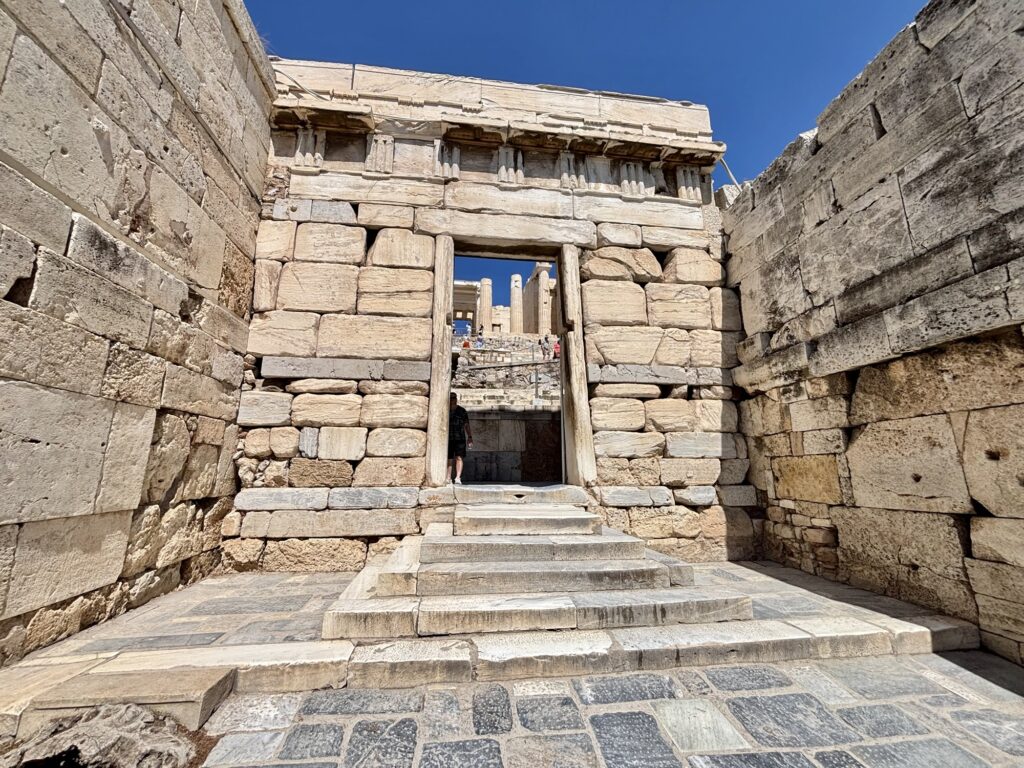
At the base of the Propylaia is an additional fortification that was built in the third century AD, during the Roman period, to provide additional reinforcement to the western slope.

Our last stop at the Acropolis was the remains of the Theatre of Dionysus on the south slope. This was something that Sara really wanted to see, because it was the birthplace of the ancient theatre both as an artistic and as an architectural concept. The structure dates back to the mid fifth century BC, and is believed to be the first theatre in existence. It was expanded over the centuries, and at its peak, it is estimated that the capacity would have been between 17,000 spectators.

One the front row, we noticed “VIP” seats with backs like we saw yesterday on Delos.
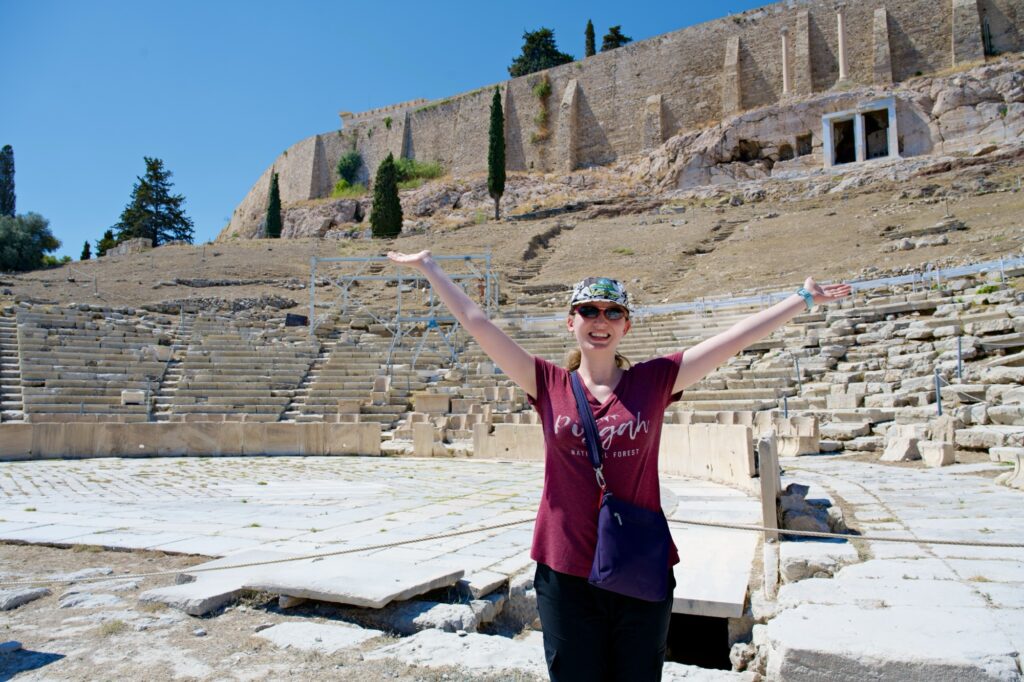
We spent a little time down here taking pictures, making sure to get one of Sara in front of the theatre, before heading back up.
The climb back up the south slope to the exit was pretty tough because it was steep and we were all completely exhausted. We took a few breaks climbing out, and then decided that we needed to call it a day. We had originally thought about trying to squeeze in one more site, but we all desperately needed a break before dinner.
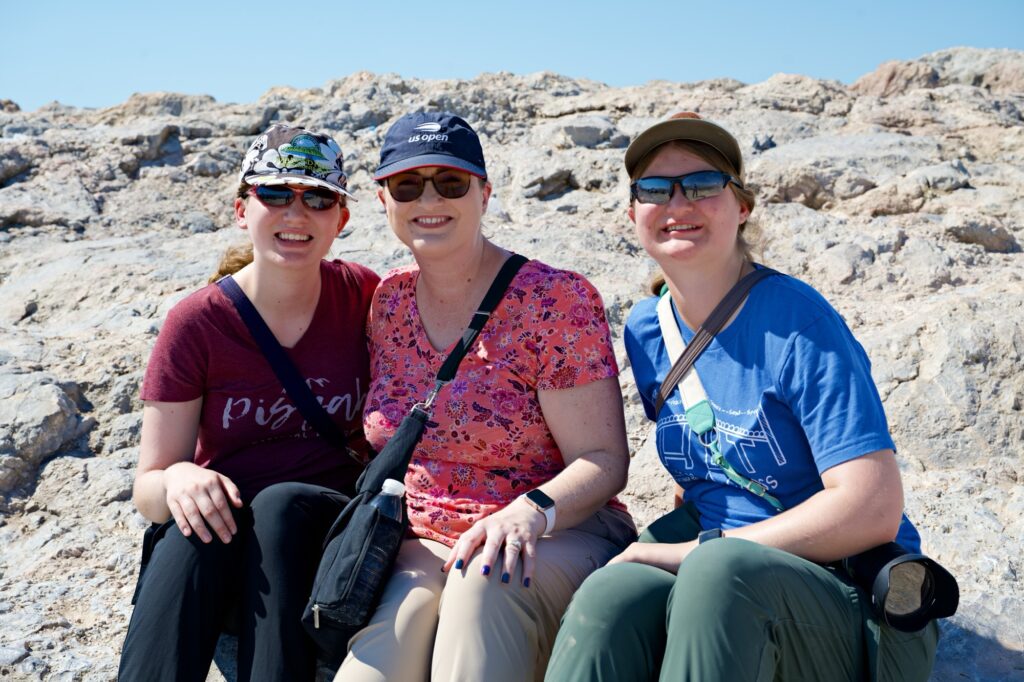
We did go back to the Areopagus one more time on the way down from the Acropolis, and I again read from Paul’s visit to Athens in Acts 17:15-34 while the girls sat on the rocks. After the short visit, we continue our descent back to the hotel.
Once back at the hotel we took some time to clean up, survey our sunburns, and rest a little bit before dinner. This was a great day, but was probably the most exhausting of the trip. Even more so for me than the day we did the Vatican and Colosseum in Rome.
Dinner
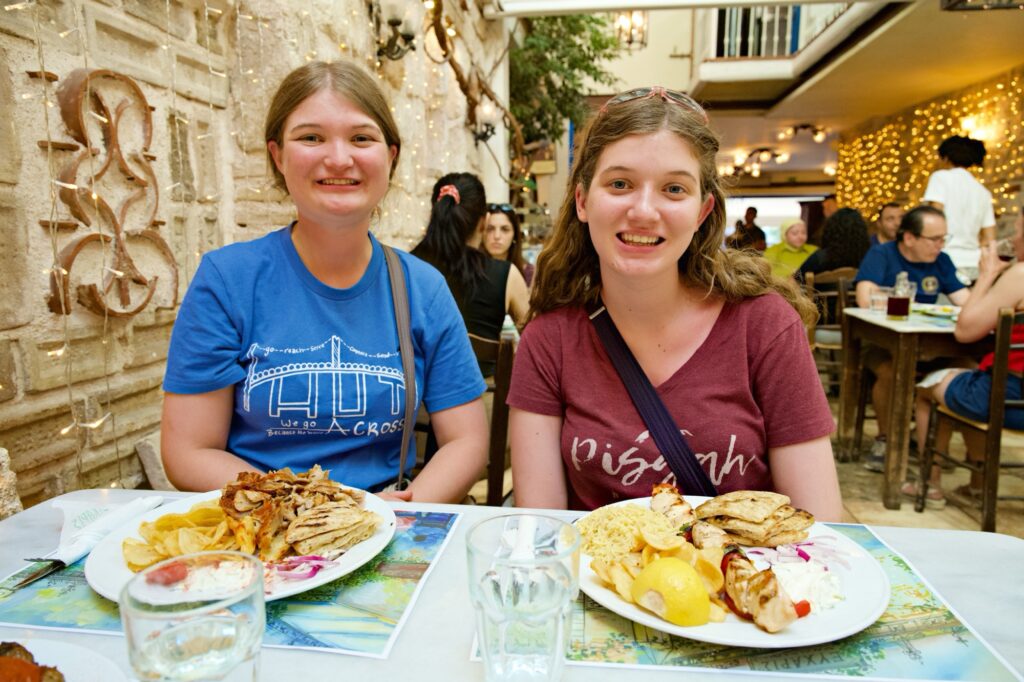
For dinner we walked back to Monastriaki Square and a found a little traditional Greek restaurant called Efcharis. It was so nice to sit inside an air conditioned restaurant after such a long, hot day. It was also very beautiful inside. Rather than ordering family style like we did in Rome, we each did our own thing.
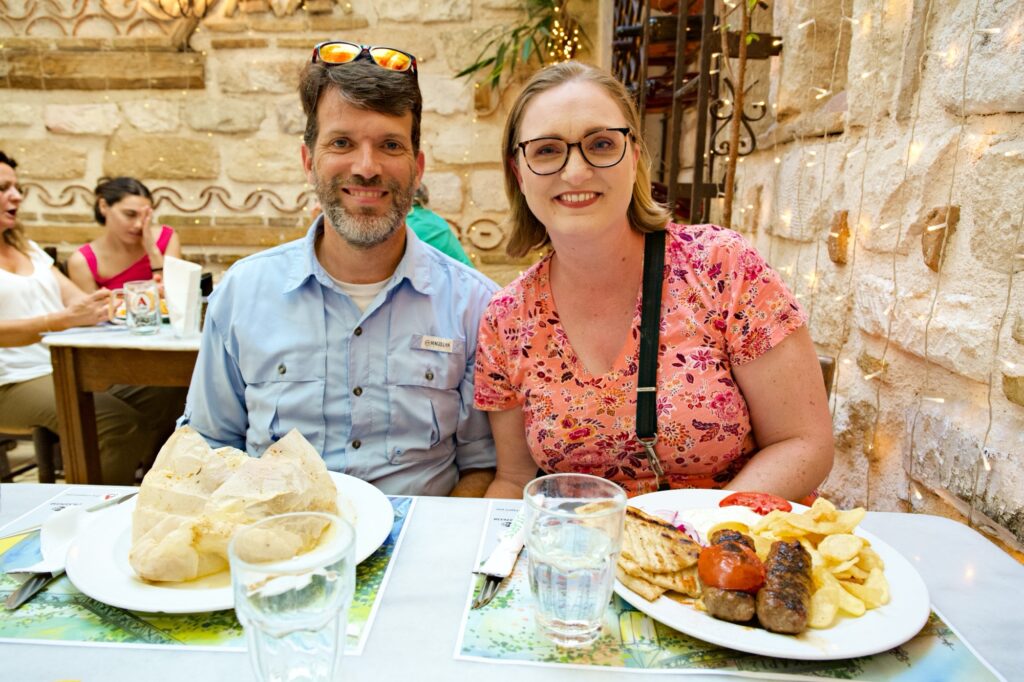
I had lamb and potatoes cooked in a parchment bag, which was amazing. Olivia had kebab politico, Kate had gyro pork, and Sara had chicken souvlaki. We did share a little bit, and it was all fantastic
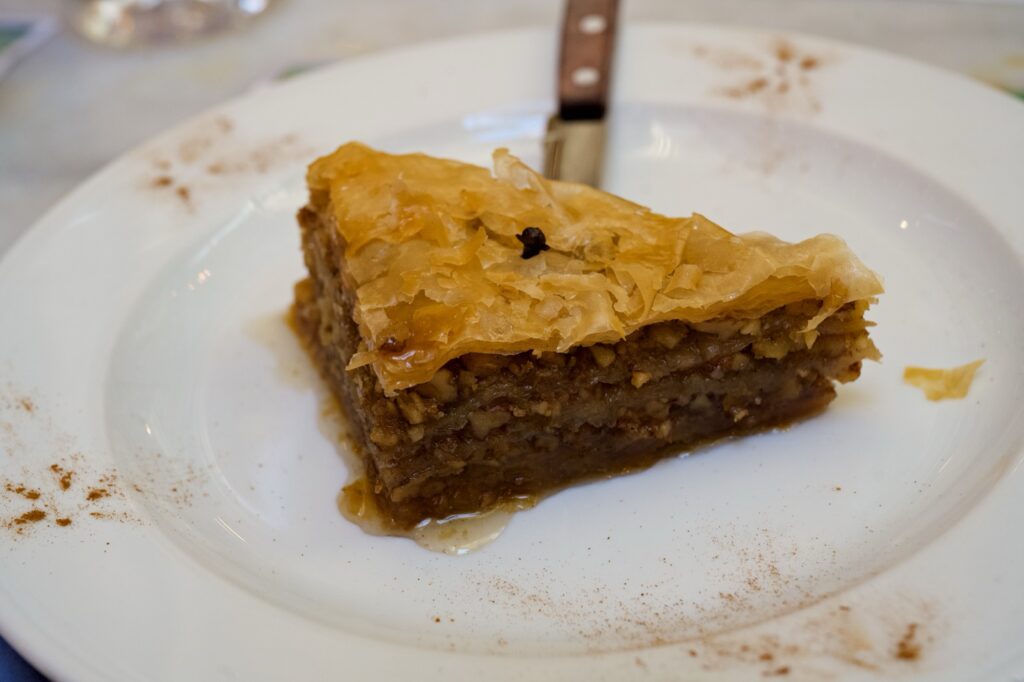
For dessert, we all had Baklava, which was so, so, so, so good! I’ve had lots of baklava in the states, but my two times having Baklava in Greece so far have been beyond comparison.
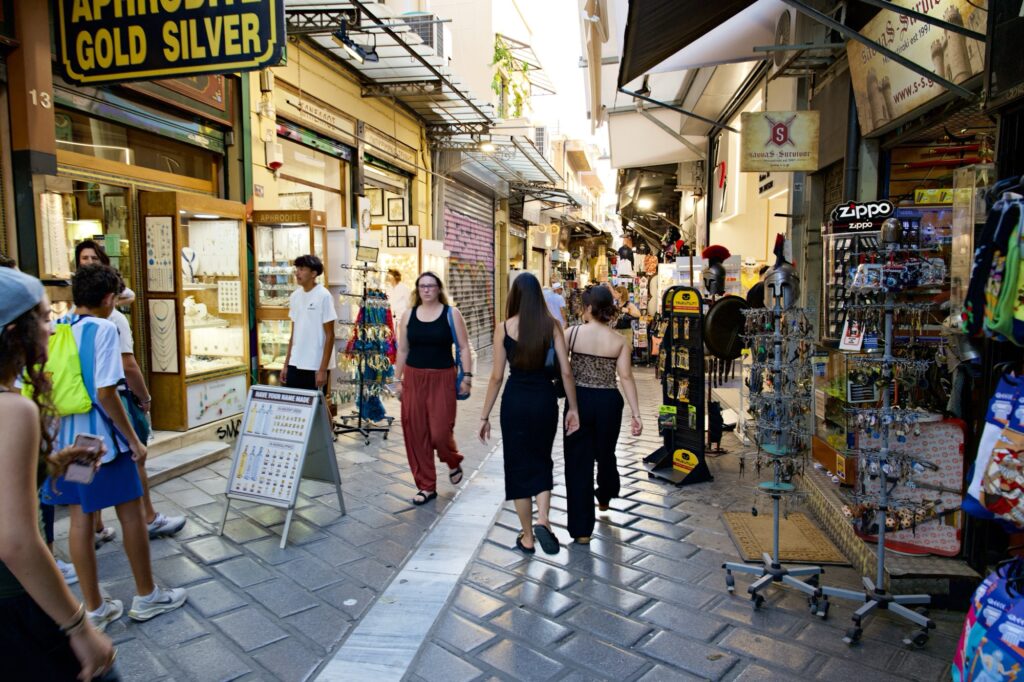
After dinner, we did a little sopping in the modern Agora Athens Flea Market attached to Monastriaki Square before heading back to the hotel and turning in for the night. What a Day!!
